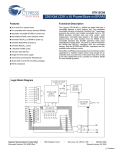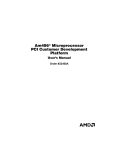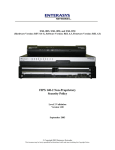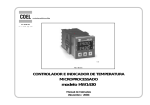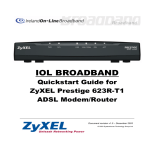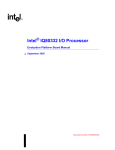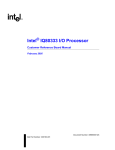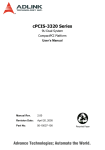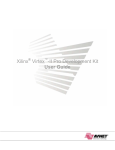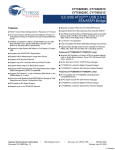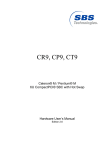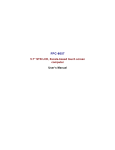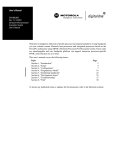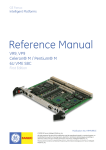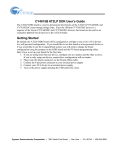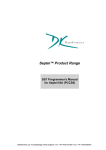Download GE Fanuc / SBS CM4 Manual
Transcript
Artisan Technology Group is your source for quality new and certified-used/pre-owned equipment • FAST SHIPPING AND DELIVERY • TENS OF THOUSANDS OF IN-STOCK ITEMS • EQUIPMENT DEMOS • HUNDREDS OF MANUFACTURERS SUPPORTED • LEASING/MONTHLY RENTALS • ITAR CERTIFIED SECURE ASSET SOLUTIONS SERVICE CENTER REPAIRS Experienced engineers and technicians on staff at our full-service, in-house repair center WE BUY USED EQUIPMENT Sell your excess, underutilized, and idle used equipment We also offer credit for buy-backs and trade-ins www.artisantg.com/WeBuyEquipment InstraView REMOTE INSPECTION LOOKING FOR MORE INFORMATION? Visit us on the web at www.artisantg.com for more information on price quotations, drivers, technical specifications, manuals, and documentation SM Remotely inspect equipment before purchasing with our interactive website at www.instraview.com Contact us: (888) 88-SOURCE | [email protected] | www.artisantg.com Preliminary Edition Rev F Artisan Technology Group - Quality Instrumentation ... Guaranteed | (888) 88-SOURCE | www.artisantg.com Copyright Copyright © 2005 - SBS Technologies, Inc. All rights reserved. CM4 User's Manual - Rev. F This document and its contents are provided as is, with no warranties of any kind, whether express or implied, including warranties of design, merchantability, and fitness for a particular purpose, or arising from any course of dealing, usage, or trade practice. The content of this manual is furnished for informational use only and is subject to change without notice. Reverse engineering of any SBS product is strictly prohibited. In no event will SBS be liable for any lost revenue or profits or other special, indirect, incidental and consequential damage, even if SBS has been advised of the possibility of such damages, as a result of the usage of this document and the product that this document describes. SBS and the SBS logo are trademarks of SBS Technologies. Intel is a trademark of Intel Corporation. IBM and PowerPC are trademarks of International Business Machines (IBM). CompactPCI is a trademark of the PCI Industrial Computer Manufacturers Group. VxWorks is a trademark of WindRiver Systems, Inc. SBS Technologies 7401 Snaproll Albuquerque, NM 87109-4358 Tel 505.875.0600 Fax 505.478.1400 Email [email protected] Document #:70000340-800 Rev. E and 70000345-800 Rev. E Conventions The following conventions are used in this user’s guide: • Signal names are designated with all capital letters (e.g. SYSEN#) • Signal names followed by the pound sign (#) are active-low (e.g. SYSEN#) • Data addresses written in hexadecimal are designated with the prefix 0x (e.g. 0xF000_0000) CM4 User’s Guide—SBS Technologies Artisan Technology Group - Quality Instrumentation ... Guaranteed | (888) 88-SOURCE | www.artisantg.com ii Preliminary SBS shall have no liability with respect to the infringement of copyrights, trade secrets, or any patents by this document or any part thereof. Table of Contents Chapter 1: Introduction 1.1 1.2 1.3 1.4 1.5 Overview ............................................................................................................... 1-1 Specification ......................................................................................................... 1-3 Block Diagram ...................................................................................................... 1-4 Technical Support ................................................................................................. 1-5 Related Documents ............................................................................................... 1-5 2.1 What is included ................................................................................................... 2-1 2.2 Equipment Needed ................................................................................................ 2-1 2.3 Power .................................................................................................................... 2-2 2.4 Installation ............................................................................................................ 2-3 Chapter 3: Board Description 3.1 Physical Description ............................................................................................. 3-1 3.2 Power .................................................................................................................... 3-1 3.3 Connector Locations ............................................................................................. 3-2 3.4 Front Panel ............................................................................................................ 3-2 3.5.1 CompactPCI Connectors ........................................................................... 3-3 3.5.2 PMC Connectors ........................................................................................ 3-5 3.5.3 JTAG/COP Port (P1100) ........................................................................... 3-7 3.6 Memory/X-bus ...................................................................................................... 3-8 3.7 Memory Map ...................................................................................................... 3-10 3.7.1 I/O Devices .............................................................................................. 3-11 3.8 PCI Arbitration ................................................................................................... 3-11 3.9 PCI IDSEL .......................................................................................................... 3-12 3.10 Serial I/O Communications ................................................................................ 3-12 3.11 Digital I/O Communications ............................................................................... 3-14 CM4 User’s Guide—SBS Technologies Artisan Technology Group - Quality Instrumentation ... Guaranteed | (888) 88-SOURCE | www.artisantg.com iii Preliminary Chapter 2: Getting Started Preliminary 3.12 Ethernet I/O Communications ............................................................................ 3-16 3.13 System Controller vs. Peripheral Operation ....................................................... 3-16 3.14 Reset Circuitry .................................................................................................... 3-17 3.14.1 Hard Resets .............................................................................................. 3-17 3.14.2 Soft Resets ............................................................................................... 3-20 3.14.3 PCI Resets ................................................................................................ 3-20 3.14.4 Watchdog Timer ...................................................................................... 3-21 3.15 Interrupt Circuitry ............................................................................................... 3-22 3.15.1 PCI Interrupts ........................................................................................... 3-22 3.15.2 On-board Interrupts .................................................................................. 3-25 3.16 Clock Circuitry ................................................................................................... 3-26 3.16.1 24MHz and 14.318MHz Clocks .............................................................. 3-26 3.16.2 Real-Time Clock ...................................................................................... 3-26 3.16.3 Tsi107 Clock Distribution ....................................................................... 3-27 3.16.4 PCI 6254 PCI Bridge Clock Operation—Transparent Mode .................. 3-29 3.16.5 PCI 6254 PCI Bridge Clock Operation—Non-Transparent Mode .......... 3-29 Chapter 4: Components 4.1 Component Location ............................................................................................. 4-1 4.2 Processors ............................................................................................................. 4-2 4.3 Tsi107 Host Bridge ............................................................................................... 4-3 4.3.1 System Bus Interface ................................................................................. 4-3 4.3.2 Memory Controller and Bus Interface ....................................................... 4-3 4.3.3 PCI Bus Interface ....................................................................................... 4-3 4.3.4 Interrupt Controller .................................................................................... 4-3 4.4 PCI 6254 PCI Bridge ............................................................................................ 4-4 4.5 SDRAM ................................................................................................................ 4-4 4.6 Flash Memory ....................................................................................................... 4-4 4.6.1 Boot Flash .................................................................................................. 4-4 4.6.2 Extended Flash ........................................................................................... 4-4 4.7 Decoder CPLD ...................................................................................................... 4-5 4.8 82559ER Ethernet Controller ............................................................................... 4-5 4.9 ST16C2550 Dual Channel UARTs ....................................................................... 4-5 4.10 STK14C88 NVSRAM .......................................................................................... 4-6 4.11 DS1685 Real-Time Clock ..................................................................................... 4-6 Chapter 5: CPLD Registers 5.1 iv Watchdog Control Register .................................................................................. 5-1 CM4 User’s Guide—SBS Technologies Artisan Technology Group - Quality Instrumentation ... Guaranteed | (888) 88-SOURCE | www.artisantg.com 5.2 5.3 5.4 5.5 5.6 5.7 5.8 5.9 MCP Ticker Control Register ............................................................................... 5-2 MCP Ticker Reset Register .................................................................................. 5-2 Interrupt Status Register ....................................................................................... 5-3 Interrupt Mask Register ........................................................................................ 5-4 Status Input Port Register ..................................................................................... 5-5 Status Output Port Register ................................................................................... 5-6 CPLD Version Register ........................................................................................ 5-6 Digital I/O Registers ............................................................................................. 5-7 5.9.1 DOUT Register .......................................................................................... 5-7 5.9.2 DOUTEN Register ..................................................................................... 5-8 5.9.3 DINQ Register ........................................................................................... 5-8 5.10 DI/O Interrupt Status Register .............................................................................. 5-9 5.11 DI/O Interrupt Mask Register ............................................................................. 5-10 Chapter 6: Customer Service Index CM4 User’s Guide—SBS Technologies Artisan Technology Group - Quality Instrumentation ... Guaranteed | (888) 88-SOURCE | www.artisantg.com v Preliminary 6.1 Introduction ........................................................................................................... 6-1 6.2 Updated User Guides and Data Sheets ................................................................. 6-1 6.3 Customer Service .................................................................................................. 6-2 6.4 Warranty Information ........................................................................................... 6-2 6.4.1 Warranty .................................................................................................... 6-2 6.4.2 Non-Warranty Terms and Conditions ........................................................ 6-3 6.5 Return Material Authorization (RMA) ................................................................. 6-3 6.6 Documentation Feedback Form ............................................................................ 6-5 List of Figures Figure 1-1 Convection-cooled configuration.............................................................................1-2 Figure 1-2 Conduction-cooled configuration ............................................................................1-2 Figure 1-3 CM4 Block diagram.................................................................................................1-4 Figure 2-1 Power regulation recommendations.........................................................................2-2 Figure 3-1 Connector locations (convection-cooling version) ..................................................3-2 Figure 3-2 Front panel (convection-cooled configuration)........................................................3-2 Figure 3-4 Memory/X-bus network...........................................................................................3-9 Figure 3-5 Serial port circuitry ................................................................................................ 3-13 Figure 3-6 Digital I/O circuit (digital port 0)...........................................................................3-15 Figure 3-7 Ethernet circuitry....................................................................................................3-16 Figure 3-8 PCI 6254 PCI Bridge in transparent and non-transparent mode............................3-17 Figure 3-9 Power-up reset circuitry .........................................................................................3-18 Figure 3-10 Reset circuitry ........................................................................................................3-19 Figure 3-11 PCI reset when CM4 is a system controller...........................................................3-21 Figure 3-12 PCI reset when CM4 is a peripheral card ..............................................................3-21 Figure 3-13 Interrupt circuitry ...................................................................................................3-23 Figure 3-14 Decoder CPLD PCI interrupt circuitry ..................................................................3-24 Figure 3-15 Decoder CPLD interrupt circuitry..........................................................................3-25 Figure 3-16 CPU interrupt circuitry...........................................................................................3-26 Figure 3-17 Primary clock circuitry...........................................................................................3-27 Figure 3-18 PCI clock circuitry .................................................................................................3-28 Figure 3-19 cPCI clock circuitry ...............................................................................................3-30 Figure 4-1 CM4 components (front view).................................................................................4-1 CM4 User’s Guide—SBS Technologies Artisan Technology Group - Quality Instrumentation ... Guaranteed | (888) 88-SOURCE | www.artisantg.com vii Preliminary Figure 3-3 JTAG/COP port (P1100)..........................................................................................3-7 Figure 4-2 CM4 components (back side)...................................................................................4-2 Preliminary CM4 User’s Guide—SBS Technologies Artisan Technology Group - Quality Instrumentation ... Guaranteed | (888) 88-SOURCE | www.artisantg.com viii List of Tables Processor voltages.................................................................................................... 3-1 Table 3-2 CompactPCI connector P7201 pin assignments ...................................................... 3-3 Table 3-3 CompactPCI connector P7202 pin assignments ...................................................... 3-4 Table 3-4 PMC connectors P7101 and P7102 pin assignments. .............................................. 3-5 Table 3-5 PMC-P7103 pin assignments ................................................................................... 3-6 Table 3-6 JTAG/COP port pin assignments ............................................................................. 3-7 Table 3-7 Tsi107 memory map—processor view .................................................................. 3-10 Table 3-8 Tsi107 memory map—PCI bus master view ......................................................... 3-11 Table 3-9 X-bus I/O address map........................................................................................... 3-11 Table 3-10 PCI bus arbitration ................................................................................................. 3-11 Table 3-11 PCI IDSEL configuration registers ........................................................................ 3-12 Table 3-12 Serial port addresses............................................................................................... 3-12 Table 3-13 Rotated PMC interrupt connections ....................................................................... 3-22 Table 3-14 Processor system clocks......................................................................................... 3-27 Table 4-1 Processor parameters................................................................................................ 4-2 Table 4-2 Real-Time Clock time, calendar and alarm data modes .......................................... 4-7 CM4 User’s Guide—SBS Technologies Artisan Technology Group - Quality Instrumentation ... Guaranteed | (888) 88-SOURCE | www.artisantg.com ix Preliminary Table 3-1 Chapter 1: Introduction 1.1 Overview The CM4 is a 3U CompactPCI Single Board Computer (SBC) designed for network switching, routing, and front-end processing applications. It is available with multiple processor options and offers the flexibility of functioning as a system controller or peripheral card. The CM4 is available in configurations for convection-cooled or conduction-cooled environments. The CM4 offers two PowerPC Reduced Instruction Set Computer (RISC) processor options: • • MPC755—400MHz MPC7410—500MHz The CM4 implements the Tsi107 Host Bridge (replacing the MPC107 PCI Bridge chip) that includes a 64-bit 100MHz system bus interface, a memory controller with a 64-bit 100MHz memory interface, and a 32-bit 33MHz PCI interface. The memory interface accesses up to four 16M x 16 SDRAM chips for a total on-board system memory of 128MB to 512MB. Error Checking and Correction (ECC) is also included. It also accesses four 64Mb StrataFlash devices for a total on-board flash memory of 64MB. The memory bus also connects with the X-bus to access the 8MB StrataFlash boot flash, 32KB NVSRAM, Real Time Clock, and Decoder CPLD. The Tsi107 Host Bridge also provides a 32-bit PCI bus interface that connects with the 10/100Mbps 82559ER Ethernet Controller, PCI 6254 PCI Bridge, and a single PMC site. The 82559ER Ethernet Controller with integrated Medial Access Control (MAC) and physical layer (PHY) provides a 10Base-T and 100Base-TX network communications interface through the cPCI P7202 (P2) connector to the backplane or an optional CM4 Transition Module (TM), which provides either a RJ-45 connector mounted on a rear panel or a surface-mounted connector. The CM4 includes two ST16C2550 Dual Channel UART Transceivers that provide two RS-232 serial ports and two RS-422/485 serial ports. All four channels operate in full-duplex mode and include 16 bytes of FIFO transmit and 16 bytes of FIFO receive memory. In addition to serial and Ethernet I/O, the CM4 offers four programmable digital I/O channels that can be used for manufacturing process control lines. The PCI 6254 PCI Bridge connects the PCI bus (bus 0) to the cPCI backplane (bus1). Because the CM4 can function as a system controller or a peripheral card, the PCI 6254 PCI Bridge (formerly CM4 User’s Guide—SBS Technologies Artisan Technology Group - Quality Instrumentation ... Guaranteed | (888) 88-SOURCE | www.artisantg.com 1-1 Preliminary Each processor includes 32KB L1 instruction and 32KB L1data caches. The MPC755 comes with 1MB of backside L2 cache; the MPC7410 processor comes with 2MB of backside L2 cache. Introduction HB6) must change how it handles data and PCI signals according to the mode in which the CM4 is operating. When the CM4 is a system controller, the PCI 6254 is in transparent mode, which means the PCI host—the Tsi107 Host Bridge—looks through the PCI 6254 to the backplane, to the PCI devices on other peripheral cards throughout the system. When the CM4 is a peripheral card, the PCI 6254 PCI Bridge is in non-transparent mode, which means that it sees the Tsi107 Host Bridge as PCI device, but cannot look past it to the backplane. This affects how the PCI 6254 handles interrupts and reset signals. The CM4 incorporates additional flexibility with a PMC site for adding additional I/O capability with over 30 user-defined I/O lines. Preliminary The CM4 offers configurations for either convection-cooled or conduction-cooled environment. Figure 1-1 Convection-cooled configuration Figure 1-2 Conduction-cooled configuration 1-2 CM4 User’s Guide—SBS Technologies Artisan Technology Group - Quality Instrumentation ... Guaranteed | (888) 88-SOURCE | www.artisantg.com Introduction 1.2 Specification Processor • MPC755 (400MHz) • MPC7410 (500MHz) • On-chip L1 cache (32KB instruction, 32KB data, all processors) Power Requirements • +3.3V • +5V • ±12V (for installed PMC only) L2 Cache • MPC755—1MB • MPC7410—2MB Environmental Requirements* • Operating temperature Standard: 0° to +70°C Extended: -40° to +85°C Tsi107 Host Bridge • 64-bit 100MHz system bus interface • 32-bit 33MHz PCI bus interface • Memory controller with 64-bit 100MHz memory interface • 2 DMA controllers Communications • Serial ports—asynchronous full-duplex 16550-compatible UARTs 2 RS-232 ports 2 RS-422/485 ports • Fast Ethernet—82559ER 10Base-T 100Base-TX Auto-negotiation • Digital I/O 4 register-controlled ports • • • • • Storage temperature: Standard: -40° to +85°C Extended: -55° to +105°C Humidity: 5–95% @40°C Altitude: Operating: 15,000 ft. (4.5Km) Storage: 40,000 ft. (12Km) Shock: C-style: 12g/6ms R-style: 20g/6ms N-style: 100g/6ms Vibration: C-style: 2g rms/5 to 100Hz R-style: 2g rms/5 to 2KHz N-style: 14g rms/5 to 2KHz (N-style: 30 minutes each axis) Preliminary Memory • 72-bit (w/ECC)100MHz SDRAM 128–512MB supported • 64-bit 64MB flash memory • 8-bit 8MB boot flash • 32kB non-volatile SRAM automatic data transfer to and from EEPROM Software • BSP with VxWorks O/S * All values under typical conditions w/o PMC module installed. Warranty • Two year warranty CM4 User’s Guide—SBS Technologies Artisan Technology Group - Quality Instrumentation ... Guaranteed | (888) 88-SOURCE | www.artisantg.com 1-3 Introduction 1.3 Block Diagram Processor L2 Cache PPC 755 PPC 7410 SDRAM 4 pcs. JTAG/COP P1100 Boot Flash STK14C88 NVSRAM ST16C2550 UART Serial I/O RTC Decoder CPLD Tsi107 Host Bridge Preliminary Memory/X-bus StrataFlash PCI bus 4 pcs. ST16C2550 UART Serial I/O CPCI_P7201 PCI bus 82559ER Ethernet CPCI_P7202 PCI 6254 PCI Bridge PMC Site P7102 P7101 P7103 Figure 1-3 CM4 Block diagram NOTE: The Memory/X-bus represents a network of buses shown in greater detail in “Memory/X-bus” on page 3-8. 1-4 CM4 User’s Guide—SBS Technologies Artisan Technology Group - Quality Instrumentation ... Guaranteed | (888) 88-SOURCE | www.artisantg.com Introduction 1.4 Technical Support Most issues can be resolved by referring to this manual. If any problems cannot be resolved, please contact SBS Technical Support by: • E-mail: [email protected] • Telephone: (919) 851-1101 (ask for technical support) • Fax.: (919) 851-2844 For more information, refer to “Customer Service” on page 6-2. 1.5 Related Documents For more information on CM4 components, refer to the following documents: Components • • • • • • • • • • CM4 User’s Guide—SBS Technologies Artisan Technology Group - Quality Instrumentation ... Guaranteed | (888) 88-SOURCE | www.artisantg.com Preliminary • MPC755 RISC Processor Hardware Specification—Motorola, Inc., MPC750EC/D Rev. 6, September 2002 MPC7410 RISC Microprocessor Hardware Specification—Motorola, Inc., MPC7410EC/D Rev. 0.3, April 2001 MPC107 PCI Bridge/Memory Controller User’s Manual—Motorola, Inc., MPC107UM/D Rev. 0, November 2000 Tsi107™ PowerPC™ Host Bridge User’s Manual—Tundra Semiconductor Corporation,80C2000_MA001_03, January 2004 PCI 6254 (HB6) Dual Mode Universal PCI-to-PCI Bridge DataBook—PLX Technology, Inc., Version 2.0, May 2003 3Volt Synchronous Intel StrataFlash® Memory Data Sheet—Intel® Corporation, Order number 290737-004, February 2002 82559ER Fast Ethernet PCI Controller Data Sheet—Intel® Corporation, Order number 714682-002, Revision 1.3, March 2001 XC95144XL High Performance CPLD—Xilinx, Inc., Preliminary Production Specification - Version 1.2, November 1998 STK14C88 32K x 8 AutoStore™ nvSRAM QuantumTrap™ CMOS Nonvolatile Static RAM—Simtek Corporation, Document Control # ML0014 rev. 0.0, December 2002 ST16C2550 3.3V and 5V DUART with 16-bit FIFO—EXAR Corporation, Rev. 4.1, March 2002 DS1685/DS1687 3V/5V Real-Time Clock—Dallas Semiconductor Corporation, DS1685/DX1687 1-5 Introduction Specifications • • • • • • PowerPC Reference Platform Specification—IBM Corporation, Version 1.1 PICMG 2.0 CompactPCI Specification—Rev 3.0, October 1999 PICMG 2.3 PMC on CompactPCI—Rev. 1.0, August 1998 PCI Local Bus Specification—PCI Special Interest Group, Revision 3.0 Draft Standard for Common Mezzanine Card Family—CMC, IEEE Standards Department, P1386/Draft 2.0 Draft Standard Physical and Environmental layers for PCI Mezzanine Cards—PMC, IEEE Standards Department, P1386/Rev 1.0 1. PICMG Specifications are available to PICMG members only. SBS Technologies is not authorized to distribute copies of these specifications. More information can be found at http://www.picmg.org. Preliminary 2. Data sheets from hardware components can be downloaded from individual vendors web sites. 1-6 CM4 User’s Guide—SBS Technologies Artisan Technology Group - Quality Instrumentation ... Guaranteed | (888) 88-SOURCE | www.artisantg.com Chapter 2: Getting Started 2.1 What is included The CM4 is shipped with the following items: • CM4 SBC printed circuit board 2.2 Equipment Needed The following items are needed to install and operate the CM4: • • Host computer with terminal/console program CompactPCI-compatible chassis with system controller card installed CM4 Transition Module (optional) (recommended for convection-cooled applications) Ethernet cable 1:1 Serial cable Preliminary • • • E.S.D Caution! Always use proper Electrostatic Discharge (ESD) protection when handling printed circuit boards to avoid seriously damaging components. Product handlers must always be properly grounded. CM4 User’s Guide—SBS Technologies Artisan Technology Group - Quality Instrumentation ... Guaranteed | (888) 88-SOURCE | www.artisantg.com 2-1 Getting Started 2.3 Power The CM4 is designed for +3.3V operation but will tolerate +5V. The MIC2903 DC/DC Converter taps the +3.3V rail to provide a +2.5V line. The LTC1727 Power Monitor monitors the +3.3V and +2.5V line. Caution! Processor manufacturers recommend the following power restrictions for long term product reliability.To comply with these power restrictions, it is recommended the CompactPCI chassis use a dual power supply that complies with the ATX Power Supply Design Guide, Version 1.2. Preliminary VCC5 1 VCC3 2 Figure 2-1 Power regulation recommendations NOTES: 2-2 1. VCC3 (+3.3V) must not exceed VCC (+5V) by more than +0.6V for more than 20ms at any time including power-up and power-down. 2. VCC5 (+5V) must not exceed VCC3 (+3.3V) by more than +3.6V for more than 20ms at any time including power-up and power-down. CM4 User’s Guide—SBS Technologies Artisan Technology Group - Quality Instrumentation ... Guaranteed | (888) 88-SOURCE | www.artisantg.com Getting Started 2.4 Installation This installation procedure is a sample bootup scheme that assumes the CM4 will boot from a CM4 BSP VxWorks image located on a network or host computer. 1. Copy the BSP from the CD ROM to a permanent storage location either on a network or the host computer. At a minimum the VxWorks image must be available in an FTP server location for the CM4 during bootup. 2. Remove the CM4 from the static-safe envelope. 3. Install the CM4 in a 3U 32-bit CompactPCI-compliant chassis. Caution! The CM4 is not compatible with a 64-bit backplane. Convection-cooled Configuration Conduction-cooled Configuration 7. Slide the CM4 into the slot guide, applying even pressure to the upper and lower extraction levers. Be careful not to bend connector pins. 8. Use a 3/32-inch hex torque driver to tighten the top and bottom hex screws to 117-inch ounces (0.8-newton meters). All Configurations 9. When the CM4 has been installed in the chassis, install a serial cable from the host computer to the CM4 through either the optional CM4 Transition Module or other serial port connected to the backplane. 10. Install a Ethernet cable from the host computer or network connection to the CM4 through either the optional CM4 Transition Module or other Ethernet port connected to the backplane. 11.Apply power to the chassis. NOTE: CM4 can be installed in a system controller or peripheral slot. If the CM4 is not installed in a system slot, a system controller card must be installed in the system slot to supply a PCI reference clock to CM4. CM4 User’s Guide—SBS Technologies Artisan Technology Group - Quality Instrumentation ... Guaranteed | (888) 88-SOURCE | www.artisantg.com 2-3 Preliminary 4. Slide the CM4 into the slot guide, applying even pressure to the front panel and lower ejector handle. Be careful not to bend connector pins. 5. Push up on the lower extraction handle to seat the CompactPCI connectors in the backplane connectors. The red tab on the extraction handle should “click” when the board is locked into the chassis. 6. Tighten the large screw on the front panel, then tighten the smaller screw embedded in the extraction handle to secure the CM4 to the chassis. Getting Started Figure 2-3 Convection-cooled configuration configuration Preliminary Figure 2-2 Conduction-cooled 2-4 CM4 User’s Guide—SBS Technologies Artisan Technology Group - Quality Instrumentation ... Guaranteed | (888) 88-SOURCE | www.artisantg.com Chapter 3: Board Description 3.1 Physical Description 100mm (3.9 inches) 160mm (6.3 inches) -40° to 85° C (ambient)* -40° to 85° C (N-style: -55° C to 105° C) 10% to 95% (non-condensing) Forced air 200 LFM (min.) normal—1.3A (4.29W) normal—1.9A (9.5W) * Highest achievable operating temperature depends on processor type, speed, and ambient conditions (card edge temperature). Also, all temperature values are typical conditions without PMC module installed. 3.2 Power The CM4 inputs two voltage rails: +5V and +3.3V (see “CauTable 3-1 Processor voltages tion” on page 2-2). A linear regulator taps the +3.3V line and Processor Core Voltage outputs a +2.5V line. VI/O is taken from either the +3.3V for the MPC755 processors or +2.5V for the MPC7410 processor. MPC755 +2.0V The LTC1727 power monitor tracks these voltages (+3.3V and MPC7410 +1.8V +2.5V) within a specified range. If the +3.3V supply drifts above or below its specified range, the power monitor will assert an interrupt (INT3V) to the Decoder CPLD. If it is out of range for longer than 50µs, the power monitor asserts the reset output (BOARD_RST#), which resets the CM4. If the +2.5V supply drifts outside its specified range, the power monitor will assert the VCC2.5OK signal that disables the LM2636 Buck Controller, which provides the processor core voltages. If the +2.5V supply is out of specification for longer than 50µs, the power monitor will assert the reset output (BOARD_RST#), which resets the CM4. BOARD_RST# will remain asserted for 200ms even if the +3.3V or +2.5V supply returns to the specified range. Configuration resistors on the input of the LM2636 Buck Controller set processor core voltages (VCCP) according to the installed processor as listed in Table 3-1. CM4 User’s Guide—SBS Technologies Artisan Technology Group - Quality Instrumentation ... Guaranteed | (888) 88-SOURCE | www.artisantg.com 3-1 Preliminary Height: Length: Operating temperature: Storage temperature: Humidity: Cooling: Power (+3.3VDC ±5%): Power (+5VDC ±5%): Board Description 3.3 Connector Locations PMC P7101 PMC P7102 cPCI P7202 Preliminary cPCI P7201 JTAG P1100 PMC P7103 Figure 3-1 Connector locations (convection-cooling version) 3.4 Front Panel The CM4 front panel (convection-cooled configuration only) provides access to a PMC module front panel. It also includes a locking extraction handle at the bottom of the front panel and two screws: a large screw at the top and a smaller screw embedded in the extraction handle, to secure the CM4 to the chassis. The conduction-cooled configuration of the CM4 has two extraction levers with no front panel (see Figure 2-2 on page 2.4). Figure 3-2 Front panel (convection-cooled configuration) 3-2 CM4 User’s Guide—SBS Technologies Artisan Technology Group - Quality Instrumentation ... Guaranteed | (888) 88-SOURCE | www.artisantg.com Board Description 3.5 Connectors 3.5.1 CompactPCI Connectors Caution! The CM4 is not compatible with a 64-bit backplane. Table 3-2 CompactPCI connector P7201 pin assignments Pin A B C D E F +5V N/C S_ENUM# +3.3V +5V DGND J1-24 S_AD01 +5V VI/O S_AD00 ACK64# DGND J1-23 +3.3V S_AD04 S_AD03 +5V AD02 DGND J1-22 S_AD07 GND +3.3V S_AD06 AD05 DGND J1-21 +3.3V S_AD09 S_AD08 S_M66EN C/BE[0]# DGND J1-20 S_AD12 GND VI/O S_AD11 AD10 DGND J1-19 +3.3V S_AD15 S_AD14 GND AD13 DGND J1-18 S_SERR# GND +3.3V S_PAR C/BE[1]# DGND J1-17 +3.3V N/C N/C GND PERR# DGND J1-16 S_DEVSEL# GND S_VI/O S_STOP# LOCK# DGND J1-15 +3.3V S_FRAME# S_IRDY# GND TRDY# DGND Preliminary J1-25 J1-12 to 14 J1-11 S_AD18 S_AD17 S_AD16 GND S_C/BE[2]# DGND J1-10 S_AD21 GND +3.3V S_AD20 S_AD19 DGND J1-9 S_C/BE[3]# S_IDSEL S_AD23 GND S_AD22 DGND J1-8 S_AD26 GND S_VI/O S_AD25 S_AD24 DGND J1-7 S_AD30 S_AD29 S_AD28 GND S_AD27 DGND J1-6 S_REQ0# GND +3.3V S_CLK0 S_AD31 DGND J1-5 N/C N/C S__RST# GND S_GNT0# DGND J1-4 N/C GND S_VI/O N/C N/C DGND J1-3 S_INTA# S_INTB# S_INTC# +5V S_INTD# DGND J1-2 N/C +5V N/C N/C N/C DGND J1-1 +5V -12V N/C +12 +5V DGND CM4 User’s Guide—SBS Technologies Artisan Technology Group - Quality Instrumentation ... Guaranteed | (888) 88-SOURCE | www.artisantg.com 3-3 Board Description Table 3-3 CompactPCI connector P7202 pin assignments Preliminary Pin A B C D E F J2-22 GA4 GA3 GA2 GA1 GA0 DGND J2-21 SCLK6 GND PMCI/O_24 ETX+ ERX+ DGND J2-20 SCLK5 GND PMCI/O_23 ETC ERC DGND J2-19 GND GND PMCI/O_27 ETX- ERX- DGND J2-18 PMCI/O_25 PMCI/O_26 PMCI/O_22 PMCI/O_28 BATT+ DGND J2-17 PMCI/O_12 PMCI/O_10 RST_BUT# S_REQ6# S_GNT6# DGND J2-16 PMCI/O_38 PMCI/O_36 DEG#* GND PMCI/O_33 DGND J2-15 PMCI/O_52 PMCI/O_50 FAL3* S_REQ5# S_GNT5# DGND J2-14 PMCI/O_18 PMCI/O_16 PMCI/O_19 PMCI/O_21 PMCI/O_20 DGND J2-13 S2_TXD DI/O_00 PMCI/O_17 S4_CTS- S4_CTS+ DGND J2-12 S2_RXD PMCI/O_13 PMCI/O_14 PMCI/O_15 S4_RTS- DGND J2-11 PMCI/O_11 DI/O_02 PMCI/O_30 S4_TXD+ S4_RTS+ DGND J2-10 PMCI/O_08 PMCI/O_09 BIT_OK PMCI/O_29 S4_TXD- DGND J2-9 PMCI/O_06 DI/O_03 PMCI/O_07 S4_RXD- S4_RXD+ DGND J2-8 PMCI/O_03 PMCI/O_04 S3_RXD+ PMCI/O_05 S3_CTS+ DGND J2-7 DI/O_06 DI/O_04 PMCI/O_02 S3-RTS+ S3_CTS- DGND J2-6 S1_TXD S1_RXD S3_RXD- PMCI/O_01 S3_RTS- DGND J2-5 DI/O_07 DI/O_01 WDG_REL S3_TXD- S3_TXD+ DGND J2-4 S_VI/O DI/O_05 A_DI/O BOOTSEL B_DI/O DGND J2-3 SCLK4 GND S_GNT3# S_REQ4# S_GNT4# DGND J2-2 SCLK2 SCLK3 S_SYSEN# S_GNT2# S_REQ3# DGND J2-1 SCLK1 GND S_REQ1# S_GNT1# S_REQ2# DGND * Unused—pulled up to Vcc. 3-4 CM4 User’s Guide—SBS Technologies Artisan Technology Group - Quality Instrumentation ... Guaranteed | (888) 88-SOURCE | www.artisantg.com Board Description 3.5.2 PMC Connectors Table 3-4 PMC connectors P7101 and P7102 pin assignments. PMC P7102 PMC P7101 Pin Assignment Pin Assignment Pin Assignment Pin Assignment 1 N/C 2 -12V 1 +12V 2 N/C 3 GND 4 INTD# 3 N/C 4 N/C 5 INTA# 6 INTB# 5 N/C 6 GND 7 N/C 8 +5V 7 GND 8 N/C 9 INTC# 10 N/C 9 N/C 10 N/C GND 12 N/C 11 +5V 12 +3.3V PCLK_PMC 14 GND 13 PCI_RST# 14 GND 15 GND 16 PGNT2# 15 +3.3V 16 GND 17 PREQ2# 18 +5V 17 N/C 18 GND 19 LVDD 20 AD31 19 AD30 20 AD29 21 AD28 22 AD27 21 GND 22 AD26 23 AD25 24 GND 23 AD24 24 +3.3V 25 GND 26 C/BE[3]# 25 AD14 26 AD23 27 AD22 28 AD21 27 +3.3V 28 AD20 29 AD19 30 +5V 29 AD18 30 GND 31 LVDD 32 AD17 31 AD16 32 C/BE[2]# 33 FRAME# 34 GND 33 GND 34 RSVD 35 GND 36 IRDY# 35 TRDY# 36 +3.3V 37 DEVSEL# 38 +5V 37 GND 38 STOP# 39 GND 40 LOCK# 39 PERR# 40 GND 41 SDONE# * 42 SBO# * 41 +3.3V 42 SERR# 43 PAR 44 GND 43 C/BE[1]# 44 GND 45 LVDD 46 AD15 45 AD14 46 AD13 47 AD12 48 AD11 47 GND 48 AD10 49 AD09 50 +5V 49 AD08 50 +3.3V 51 GND 52 C/BE[0]# 51 AD07 52 RSVD 53 AD06 54 AD05 53 +3.3V 54 RSVD 55 AD04 56 GND 55 RSVD 56 GND 57 LVDD 58 AD03 57 RSVD 58 RSVD 59 AD02 60 AD01 59 GND 60 RSVD 61 AD00 62 +5V 61 ACK64# * 62 +3.3V 63 GND 64 REQ64# * 63 GND 64 RSVD Preliminary 11 13 * Not used—pulled up to Vcc. CM4 User’s Guide—SBS Technologies Artisan Technology Group - Quality Instrumentation ... Guaranteed | (888) 88-SOURCE | www.artisantg.com 3-5 Board Description Table 3-5 PMC-P7103 pin assignments PMC P7103 Preliminary Pin 3-6 Assignment Pin Assignment 1 PMCI/O_01 2 PMCI/O_02 3 PMCI/O_03 4 PMCI/O_04 5 PMCI/O_05 6 PMCI/O_06 7 PMCI/O_07 8 PMCI/O_08 9 PMCI/O_09 10 PMCI/O_10 11 PMCI/O_11 12 PMCI/O_12 13 PMCI/O_13 14 PMCI/O_14 15 PMCI/O_15 16 PMCI/O_16 17 PMCI/O_17 18 PMCI/O_18 19 PMCI/O_19 20 PMCI/O_20 21 PMCI/O_21 22 PMCI/O_22 23 PMCI/O_23 24 PMCI/O_24 25 PMCI/O_25 26 PMCI/O_26 27 PMCI/O_27 28 PMCI/O_28 29 PMCI/O_29 30 PMCI/O_30 31 N/C 32 N/C 33 PMCI/O_01 34 N/C 35 N/C 36 PMCI/O_36 37 N/C 38 PMCI/O_38 39 N/C 40 N/C 41 N/C 42 N/C 43 N/C 44 N/C 45 N/C 46 N/C 47 N/C 48 N/C 49 N/C 50 PMCI/O_50 51 N/C 52 PMCI/O_52 53 N/C 54 N/C 55 N/C 56 N/C 57 N/C 58 N/C 59 N/C 60 N/C 61 N/C 62 N/C 63 N/C 64 N/C CM4 User’s Guide—SBS Technologies Artisan Technology Group - Quality Instrumentation ... Guaranteed | (888) 88-SOURCE | www.artisantg.com Board Description 3.5.3 JTAG/COP Port (P1100) CM4 provides a JTAG/COP port (P1100) attached to the processor for single-stepping through code on the processor. The JTAG/COP port is fully functional with EST VisionProbe II emulators. Table 3-6 JTAG/COP port pin assignments Pin Assignment Pin Assignment 1 COP_TDO 2 COP_QACK# 3 COP_TDI 4 COP_RST# 5 QREQ# 6 BVDD 7 COP_TCK 8 N/C 9 COP_TMS 10 N/C 11 COP_SRST# 12 N/C 13 COP_HRST# 14 N/C 15 CKSTP_OUT# 16 GND 15 2 1 Preliminary 16 P1100 Figure 3-3 JTAG/COP port (P1100) CM4 User’s Guide—SBS Technologies Artisan Technology Group - Quality Instrumentation ... Guaranteed | (888) 88-SOURCE | www.artisantg.com 3-7 Board Description 3.6 Memory/X-bus The Memory/X-bus shown in the block diagram (see Figure 1-3 on page 1-4) represents a network of memory data, address, and parity buses and an X-bus as shown in Figure 3-4 on page 3-9. Memory Data Buses The MCP107 Host Bridge provides a memory controller with a 64-bit memory (data) bus interface. The memory data interface is divided into two 32-bit sections: high data and low data. The 32-bit high data bus transports data to and from two 16-bit SDRAM chips and two 16-bit extended flash memory chips. The 32-bit low data bus transports data to and from the remaining two 16-bit SDRAM chips and 16-bit extended flash memory chips. The high data bus also provides an 8-bit data bus that connects to the X-bus through a 16-bit bus transceiver. Address Bus Preliminary The 14-bit address bus provides addressing for the SDRAM and ECC devices. It also sends addressing information to a 16-bit bus transceiver, which sends the addressing information to the RA bus. Parity Bus The 8-bit parity bus transports parity bits between the Tsi107 Host Bridge and the SDRAM Error Checking and Correction (ECC) device. It also connects to the RA bus. RA Bus The 24-bit RA bus carries address and parity information from two 16-bit bus transceivers to the four extended flash devices, Decoder CPLD, NVSRAM, Boot flash, and two UART Transceivers. X-Bus The 8-bit X-bus connects the Decoder CPLD, NVSRAM, Boot flash, RTC, or two UART Transceivers to Tsi107PCI Bridge through a 16-bit bus switch. The 16-bit bus switch changes the direction of data flow between read and write cycles. 3-8 CM4 User’s Guide—SBS Technologies Artisan Technology Group - Quality Instrumentation ... Guaranteed | (888) 88-SOURCE | www.artisantg.com Board Description SDRAM 0 Data—High Tsi107 Host Bridge Extended Flash 1 SDRAM 1 Address Extended Flash 2 Parity SDRAM 2 Data—Low Extended Flash 3 Address Parity Data—High 16-bit bus transceivers Extended Flash 4 ECC 16-bit bus transceivers X-bus Preliminary SDRAM 3 CPLD RA-bus NVSRAM UART BOOT FLASH UART RTC Figure 3-4 Memory/X-bus network CM4 User’s Guide—SBS Technologies Artisan Technology Group - Quality Instrumentation ... Guaranteed | (888) 88-SOURCE | www.artisantg.com 3-9 Board Description 3.7 Memory Map The Tsi107 Host Bridge supports two memory maps: Memory Map A and Memory Map B. Memory Map A conforms to the now-obsolete PowerPC Reference Platform (PReP) specification. Memory Map B conforms to the PowerPC microprocessor Common Hardware Reference Platform (CHRP) specification. At power-up or reset, CM4 selects Memory Map B as default. The memory map can be viewed from two perspectives: • • Processor view PCI bus master view Table 3-7 lists the memory map as seen from the processor point of view; Table 3-8 lists the memory map as seen from the PCI bus master point of view. Preliminary Table 3-7 Tsi107 memory map—processor view Processor Range PCI Address Range Description 0x0000_000 to 0x3FFF_FFFF No PCI cycle 0x4000_0000 to 0x77FF_FFFF Reserved 0x7800_0000 to 0x7FFF_FFFF No PCI cycle 0x8000_0000 to 0xFCFF_FFFF 0x8000_0000 to 0xFCFF_FFFF PCI memory space 0xFD00_0000 to 0xFDFF_FFFF 0x0000_0000 to 0x00FF_FFFF PCI memory space (16MB ISA) 0xFE00_0000 to 0xFEBF_FFFF 0x0000_0000 to 0x000B_FFFF PCI I/O space Local memory space1, 2 Reserved Extended ROM space3 0xFEC0_0000 to 0xFEDF_FFEF Configuration Address register4 0xFEE0_0000 to 0xFEEF_FFFF Configuration Data register 0xFEF0_0000 to 0xFEFF_FFFF 0xFEF0_0000 to 0xFEFF_FFFF 0xFF00_0000 to 0xFF7F_FFFF No PCI cycle PCI Interrupt Acknowledge Board I/O devices5 0xFF80_0000 to 0xFFFF_FFFF No PCI cycle Base ROM space6 NOTES: 1. A PC compatibility gap exists from address 0x0000_A000 to 0x0000_FFFF. A configuration register can set this memory space to either to PCI memory or system memory. 2. Maximum memory space is 512MB (0x1FFF_FFFF). 3. Maximum extended flash memory is 64MB from addresses 0x7C00_0000 to 7FFF_FFF. 4. Maximum extended flash is located from address 0x7C00_0000 to 0x77FFF_FFFF. 5. Location of board-specific I/O devices. 6. 8MB of ROM located from 0xFF80_0000 to 0xFFFF_FFFF. 3-10 CM4 User’s Guide—SBS Technologies Artisan Technology Group - Quality Instrumentation ... Guaranteed | (888) 88-SOURCE | www.artisantg.com Board Description Table 3-8 Tsi107 memory map—PCI bus master view Transactions Address Range Processor Address Range Definition I/O Transactions 0x0000_0000 to 0x0000_FFFF No local memory cycle PCI—I/O space 0x0001_0000 to 0x007F_FFFF No local memory cycle Reserved 0x0080_0000 to 0x00BF_FFFF No local memory cycle PCI—I/O space 0x00C0_0000 to 0xFFFF_FFFF No local memory cycle Reserved Memory Transactions 0x0000_0000 to 0x3FFF_FFFF 0x0000_0000 to 0x7FFF_FFFF 0x4000_0000 to 0x77FF_FFFF No local memory cycle 0x7800_0000 to 0x7FFF_FFFF 0x7800_0000 to 0x7FFF_FFFF System memory Reserved Extended flash/ROM space 0x8000_0000 to 0xFDFF_FFFF PCI memory space 0xFE00_0000 to 0xFEFF_FFFF Reserved 0xFF00_0000 to 0xFF7F_FFFF 0xFF00_0000 to 0xFF7F_FFFF Board I/O device space 0xFF80_0000 to 0xFFFF_FFFF 0xFF80_0000 to 0xFFFF_FFFF Flash/ROM space Table 3-9 X-bus I/O address map X-bus I/O Address Range Function 0xFF00_0000 to 0xFF00_7FFF 32kB STK14C88 NVSRAM 0xFF00_8000 to 0xFF00_8002 Watchdog and MCP counter registers 0xFF00_8010 to 0xFF00_8013 Interrupt control registers 0xFF00_8020 to 0xFF00_802F ST16C2550 UART Serial controller—ports 1 and 2 0xFF00_8030 to 0xFF00_803F ST16C2550 UART Serial controller—ports 3 and 4 0xFF00_8040 to 0xFF00_8041 DS1285 Real-Time Clock 0xFF00_8050 to 0xFF00_8052 Status Input and Status Output port 0xFF00_8060 to 0xFF00_8063 Digital I/O register 3.8 PCI Arbitration The Tsi107 provides bus arbitration for PCI devices on the PCI bus listed in Table 3-10. Table 3-10 PCI bus arbitration PCI Bus Request CPU (internal) PCI Master Tsi107 Host Bridge REQ/GND 0 PCI 6254 PCI bridge REQ/GND 1 82559ER Ethernet controller REQ/GND 2 PMC site CM4 User’s Guide—SBS Technologies Artisan Technology Group - Quality Instrumentation ... Guaranteed | (888) 88-SOURCE | www.artisantg.com 3-11 Preliminary 3.7.1 I/O Devices The Tsi107 Host Bridge provides memory mapping for the devices listed in Table 3-9 through the X-bus. Board Description 3.9 PCI IDSEL Each PCI device requires a unique PCI address connected to the IDSEL line. Table 3-11 lists the IDSEL for each PCI device and address for the associated configuration registers. Table 3-11 PCI IDSEL configuration registers IDSEL PCI Config. Register Device AD12 0x8000_60nn PCI 6254 PCI bridge AD13 0x8000_68nn 82599ER Ethernet controller AD14 0x8000_70nn PMC slot * “nn” represents the address of the configuration register Preliminary 3.10 Serial I/O Communications The CM4 includes four asynchronous serial ports: two RS-232 and two RS-422/485, implemented in two dual ST16C2550 UARTS. The UARTs are fully NS16450 and NS16550-compatible. Each UART includes a separate interrupt and a programmable baud generator capable of 50– 1.5M baud. Each UART communicates with the Tsi107 Host Bridge through the X-bus. Each UART channel is memory-mapped to locations listed in Table 3-12. Figure 3-5 on page 3-13 shows the serial communications circuitry. Table 3-12 Serial port addresses Serial Port Address COM1 0xFF00_8020 to 0xFF00_8027 COM2 0xFF00_8028 to 0xFF00_802F COM3 0xFF00_8030 to 0xFF00_8037 COM4 0xFF00_8038 to 0xFF00_803F NOTE: The COM3 and COM4 TXD+/- and RTS+/- drivers are disabled after bootup. These drivers can be enabled through the Data Terminal Ready (DTR) output of the COM3 and COM4 controllers. 3-12 CM4 User’s Guide—SBS Technologies Artisan Technology Group - Quality Instrumentation ... Guaranteed | (888) 88-SOURCE | www.artisantg.com Board Description P7202 UART S1_TXD TXD1 COM1 RXD1 MAX232A S1_RXD X-bus RA bus COM2 TXD2 S2_TXD RXD2 S2_RXD B6 A13 A12 MAX 1484 UART S3_TXD+ TXD3 X-bus A6 S3_TXD- COM3 S3_RXD+ RXD3 S3_RXD- E5 D5 C8 C6 DTR3 RA bus S3_RTS+ RTS3 S3_RTSS3_CTS+ CTS3 S3_CTS- Preliminary MAX 1484 D7 E6 E8 E7 MAX 1484 S4_TXD+ TXD4 COM4 S4_TXDS4_RXD+ RXD4 S4_RXD- D11 E10 E9 D9 DTR4 MAX 1484 RTS4 S4_RTS+ S4_RTS- CTS4 S4_CTS+ S4_CTS- E11 E12 E13 D13 Figure 3-5 Serial port circuitry CM4 User’s Guide—SBS Technologies Artisan Technology Group - Quality Instrumentation ... Guaranteed | (888) 88-SOURCE | www.artisantg.com 3-13 Board Description 3.11 Digital I/O Communications The CM4 provides five digital control I/O ports for users to control external process functions. A set of CPLD registers enables the software applications to separately control the direction and usage of each port. Figure 3-6 on page 3-15 shows the circuitry for digital I/O port 0. Each register uses five bits (6, 3:0), one for each port (see “Digital I/O Registers” on page 5-7). Preliminary The CPLD’s DOUTEN register provides five bits to control whether each port is an input or an output. The reset value for this register sets all ports to be inputs. Input ports are readable and have edge-detection circuitry that drives a maskable interrupt function. A port set to be an output is still readable, but its edge-detection circuitry is disabled. The level on output ports is directly controlled by application software. Input ports have edge-detection circuits which require a minimum input pulse width of 100ns. Pulses less than 100ns may not be detected. Once an edge in either direction is detected, a bit is set in the DI/O Interrupt Status Register. If the corresponding bit in the DI/O Interrupt Mask Register is set, the status register bit causes the assertion of an interrupt. Software can disable the interrupt source by masking it, or by writing a (1) to the bit in the DI/O Interrupt Status Register to clear it. The DINQ register is provided to allow software to read the state of the DI/O ports. Software must read the current state of a DI/O input to determine the direction of an edge that was detected. Therefore, software must consider the fact that a short pulse on an input port could cause the wrong conclusion to be drawn. Output ports are directly controlled by the values of the five software-controlled bits in the DOUT register. The corresponding bit in the DOUTEN register must be set by software to make a port an output port since they default at reset to input ports. Both of these registers are write-only registers due to resource constraints in the CPLD. 3-14 CM4 User’s Guide—SBS Technologies Artisan Technology Group - Quality Instrumentation ... Guaranteed | (888) 88-SOURCE | www.artisantg.com Board Description Decoder CPLD X-bus XD0 P7202 DOUT Register DOUT0 DOUTEN Register DOUTEN0# DINQ Register DINQ0 D I/O0 B13 0x8060 (Write) XD0 0x8061 (Write) Preliminary XD0 0x8062 (Read) Figure 3-6 Digital I/O circuit (digital port 0) CM4 User’s Guide—SBS Technologies Artisan Technology Group - Quality Instrumentation ... Guaranteed | (888) 88-SOURCE | www.artisantg.com 3-15 Board Description 3.12 Ethernet I/O Communications The CM4 includes a 82559ER Fast Ethernet Controller that provides either 10Base-T or 100Base-TX Ethernet through the CompactPCI backplane. The 82559ER Controller includes both a Media Access Controller (MAC), and a physical layer (PHY) that interfaces with the Ethernet transformer. The 82559ER can operate in either full-duplex or half-duplex mode. The 82559ER Controller is a PCI peripheral that includes a PCI interface. It also includes a 4-bit EEPROM interface. The serial EEPROM contains power-on initialization as well as configuration information. The 82559ER chip auto-negotiates for the fastest possible connection. Ethernet Transformer 82559ER Ethernet Controller Tsi107 Host Bridge TD+ Transmit P7202 ETX+ D21 Preliminary PCI bus ETX- TDSerial EEPROM ETC D19 D20 EESK EECS RD+ Receive ERC EEDI EEDO ERX+ RD- ERX- E21 E20 E19 Figure 3-7 Ethernet circuitry 3.13 System Controller vs. Peripheral Operation It is important to be aware, as it relates to the following sections, that the PCI 6254 handles reset and interrupt signals differently when the CM4 is installed in a system slot, than when the CM4 is installed in a peripheral slot as shown in Figure 3-8 on page 3-17. When the CM4 is functioning as a system controller, the PCI 6254 PCI bridge is in transparent mode, meaning it is effectively transparent to PCI reset signals sent from the Tsi107 Host Bridge out to the PCI backplane and interrupts received from the backplane to the Tsi107. When the CM4 is functioning as a peripheral, the PCI 6254 PCI Bridge is in non-transparent mode, which means that it appears to the Tsi107 as a PCI device on the PCI bus. The function of the MCP107 Host Bridge as PCI host does not change whether the CM4 is functioning as a system controller or peripheral. 3-16 CM4 User’s Guide—SBS Technologies Artisan Technology Group - Quality Instrumentation ... Guaranteed | (888) 88-SOURCE | www.artisantg.com Board Description CM4 as system controller Tsi107 Host Bridge Transparent Mode cPCI Backplane PCI 6254 PCI Bridge PCI interrupts PCI resets CM4 as peripheral. Tsi107 Host Bridge Non-transparent Mode Primary Secondary PCI interrupts PCI resets cPCI Backplane PCI 6254 PCI Bridge 3.14 Reset Circuitry The CM4 reset circuitry consists of hard and soft resets. Hard resets are asserted during power-up or by a voltage drifting out of a specified range, a manual reset, or a PCI reset from the CompactPCI backplane (discussed separately from hard resets). Soft resets are triggered by application or test and evaluation software. 3.14.1 Hard Resets The Decoder CPLD receives hard resets from the following sources: • • • Power monitor reset (BOARD_RST#) Manual reset button (RST_BUT#) External emulator reset—P1100 (COP_HRST# and COP_TRST#) Power Monitor Reset After power-up or manual reset, when the processor core voltages (VCCP) has been established to the processor, the LM2636 Buck Controller de-asserts the PWRGOOD# signal to the LTC1727 Power Monitor. The LM2636 asserts the PWRGOOD# signal when the processor core voltage (see Table 3-1 on page 3-1) goes outside a 10% window and de-asserts it when the core voltage travels back into an 8% window for at least 10ms. CM4 User’s Guide—SBS Technologies Artisan Technology Group - Quality Instrumentation ... Guaranteed | (888) 88-SOURCE | www.artisantg.com 3-17 Preliminary Figure 3-8 PCI 6254 PCI Bridge in transparent and non-transparent mode Board Description The LTC1727 Power Monitor tracks the +3.3V and +2.5V lines as well as the PWRGOOD# signal. If the +3.3V or +2.5V drift out of a 1.5% window for more than 50µs or if PWRGOOD# is asserted, the LTC1727 asserts the BOARD_RST# output to the Decoder CPLD and extended flash devices as shown in Figure 3-9. The watchdog timer output (WD_RESET) from the Decoder CPLD can also assert the PWRGOOD# line. Decoder CPLD LTC1727 Power Monitor +3.3V +2.5V BOARD_RST# PWRGOOD# Preliminary WD_RESET VID LM2636 Buck Controller PWRGOOD# Processor VCCP MPC755 MPC7410 BOARD_RST# Strata Flash Strata Flash Strata Flash Strata Flash Figure 3-9 Power-up reset circuitry Manual Reset Button The CM4 does not include a physical reset button, however, it provides for an external manual reset through the RST_BUT# signal available at CompactPCI connector P7202 (see Figure 3-10 on page 3-19). When the RST_BUT# signal is asserted, the Decoder CPLD inputs the RST_BUT# to a logical OR gate with the BOARD_RST# and COP_HRESET# signal to assert the 107_HRESET# line to the Tsi107PCI Bridge. The Tsi107 then asserts the 107_CPUHRST# signal that passes through the Decoder CPLD to reset the processor. Inside the Decoder CPLD, the 107_CPUHRST# signal is also connected through a logical OR gate with the BOARD_RST# to assert the PCI_RST#. The PCI_RST# signal resets all PCI devices on the CM4 (see “PCI Resets” on page 3-20). SBS Technologies offers a CM4 Transition Module that includes a reset switch on a rear panel or a RST_BUT# pin in the 26-pin Miscellaneous connector. 3-18 CM4 User’s Guide—SBS Technologies Artisan Technology Group - Quality Instrumentation ... Guaranteed | (888) 88-SOURCE | www.artisantg.com Board Description 107_CPUHRST# Tsi107 Host Bridge Decoder CPLD 107_SRESET# 11 4 Power-up Reset Circuitry Processor CPU_SRESET# 107_HRESET# COP 13 P1100 HRESET_CPU# CPU_TRST# COP_HRST# P_RSTIN# PCI 6254 cPCI Bridge PCI_RST# 82559ER Ethernet Controller COP_SRST# COP_RST# BOARD_RST# PCI_RST# WD_RESET# PCI_RST# RST_BUT# cPCI C17 P7202 SYSEN# Boot flash ST16C2550 UART Transceivers (2 pcs) C2 PCI 6254 cPCI Bridge S_RSTOUT# PCI_RST# CM4 is a system controller S_RST# (Transparent mode) CM4 is a peripheral card cPCI C5 P7201 S_RST# S_RSTOUT# (Non-transparent mode) 13 PMC P7102 Preliminary Watchdog Timer cPCI C5 P7201 PCI 6254 cPCI Bridge Figure 3-10 Reset circuitry CM4 User’s Guide—SBS Technologies Artisan Technology Group - Quality Instrumentation ... Guaranteed | (888) 88-SOURCE | www.artisantg.com 3-19 Board Description Emulator Reset The CM4 provides a JTAG/COP port (P1100) for board test and evaluation. The COP port provides these reset signals: Hard reset (COP_HRST#), and Test reset (COP_RST#) These reset signals are generated by test software downloaded to the CM4 through a emulator. They allow the test software to perform hard resets (complete system resets) and test resets. 3.14.2 Soft Resets The CM4 reset circuit includes two soft reset lines: Preliminary • • 107_SRESET# COP_SRESET# The Tsi107 Host Bridge outputs the 107_SRESET# to the Decoder CPLD where it is ORed with the COP_SRESET# from the COP port. The 107_SRESET# signal is triggered by application software. The COP_SRESET# is triggered by an emulator (typically test software) attached to the P1100 JTAG/COP port. If one of these reset lines is asserted, the CPU_SRESET# line is asserted causing the processor to perform a soft reset that resets the processor internal logic but does not directly affect the states of output signals. 3.14.3 PCI Resets When the CM4 is installed in a system slot, it can send PCI resets to peripheral cards in the system through the CompactPCI backplane but cannot receive PCI resets. When the CM4 is installed in a non-system controller slot, it can receive a PCI reset from the system controller but cannot send PCI resets out to the system. This dual mode capability is made possible through the transparent/non-transparent modes of the PCI 6254 PCI Bridge as previously discussed (see “System Controller vs. Peripheral Operation” on page 3-16) and the SYSEN# signal, which is asserted when the CM4 is installed in a system slot. CM4 is a System Controller When the CM4 is functioning as a system controller and it receives a hard reset, the Decoder CPLD asserts the 107_HRESET# signal to reset the Tsi107 Host Bridge and processor (see Figure 3-10 on page 3-19). The Decoder CPLD also asserts the PCI reset output, which resets the following PCI devices on the CM4: • • • • • PCI 6254 PCI Bridge (primary interface) 82559ER Ethernet Controller StrataFlash boot flash Two ST16C2550 UART Transceivers PMC site When the CM4 is the system controller, the PCI 6254 PCI Bridge operates in transparent mode. In transparent mode, the PCI 6254 receives the PCI reset signal on the primary PCI interface reset input (P_RSTIN#) input. When P_RSTIN# is asserted in transparent mode, the secondary PCI interface reset output (S_RSTOUT#) is asserted. The S_RSTOUT# line goes back to the Decoder CPLD where the asserted SYSEN# signal enables an output buffer that drives the reset onto the cPCI backplane as shown in Figure 3-11 on page 3-21. 3-20 CM4 User’s Guide—SBS Technologies Artisan Technology Group - Quality Instrumentation ... Guaranteed | (888) 88-SOURCE | www.artisantg.com Board Description cPCI P7201 Decoder CPLD PCI_RST# P_RSTIN# PCI 6254 PCI Bridge S_RSTOUT# Decoder CPLD S_RST# C5 Figure 3-11 PCI reset when CM4 is a system controller The PCI reset signal is the only signal affected by whether the CM4 is a system controller or peripheral card. CM4 is a Peripheral Card When the CM4 is installed in a non-system controller slot, the PCI 6254 PCI Bridge changes to non-transparent mode. In non-transparent mode, the PCI 6254 appears as just another PCI device on the PCI bus. The PCI 6254 receives the P_RSTIN# reset which resets the primary PCI interface but it does not pass the reset on to the secondary PCI interface. cPCI P7201 Decoder CPLD PCI_RST# P_RSTIN# PCI 6254 PCI Bridge S_RSTOUT# Decoder CPLD S_RST# C5 Figure 3-12 PCI reset when CM4 is a peripheral card 3.14.4 Watchdog Timer The Decoder CPLD includes an integrated watchdog timer that can reset the processor if development application software forces the processor into an unstable condition. After power-up or reset, the watchdog timer is disabled. A write to the Watchdog Control Register WD_ON bit (b0) (see “Watchdog Control Register” on page 5-1) enables the watchdog timer. After the watchdog timer is enabled, it counts down—duration of the count is 0.5 seconds. To reset the watchdog timer, the application software must read the Watchdog Control Register before the count expires. If the watchdog timer count expires, it sends a hard reset signal (WD_RESET#) to the LTC1727 Power Monitor, which then asserts BOARD_RST# as shown in Figure 3-10 on page 3-19. The application software can determine if a reset was triggered by the watchdog timer or some other cause by reading the Watchdog Control Register. CM4 User’s Guide—SBS Technologies Artisan Technology Group - Quality Instrumentation ... Guaranteed | (888) 88-SOURCE | www.artisantg.com 3-21 Preliminary In non-transparent mode, the secondary PCI interface reset output (S_RSTOUT#) becomes an input for system resets from the system controller. When the CM4 is a peripheral card, a PCI reset (S_RST#) is received through the CompactPCI connector P7201, and is routed through the Decoder CPLD. An input buffer enabled by the de-asserted SYSEN# signal drives the PCI reset to the PCI 6254 secondary PCI interface on the S_RSTOUT# line. The PCI reset asserted on the PCI 6254 secondary interface, resets secondary PCI interface configuration registers as shown in Figure 3-12. Board Description 3.15 Interrupt Circuitry The CM4 processor services interrupts generated from several on-board devices, as well as external interrupts from an installed PMC module or from the CompactPCI backplane when the CM4 is installed in a system slot. The Tsi107 Host Bridge includes an Embedded Programmable Interrupt Controller (EPIC) that provides five hardwire interrupt inputs. The CM4 uses four of these interrupt inputs to implement external PCI interrupts from the PCI backplane (CM4 functioning as a system controller) or from an installed PMC module (CM4 functioning either as system controller or peripheral card). The Tsi107 uses the fifth interrupt line for a combined interrupt from the on-board devices. 3.15.1 PCI Interrupts Preliminary CM4 is a System Controller When the CM4 is functioning as a system controller, the Tsi107 Host Bridge can receive up to four PCI interrupts (C_INT[A…D]#) from the CompactPCI backplane through cPCI connector P1701. In the Decoder CPLD, these four interrupts are ANDed with the system enable signal (SYSEN#) to enable open-collector outputs—INT[A…D]# to the Tsi107 EPIC unit as shown in Figure 3-14 on page 3-24. The SYSEN# signal is asserted when the CM4 is installed in a system slot. CM4 is a Peripheral Card When the CM4 is a peripheral card, inputs C_ INT[B…D]# are disabled in the Decoder CPLD and input C_INTA# becomes an output from the Decoder CPLD, driven by the PCI 6254 PCI Bridge secondary PCI interface (P6254_SINTA#). The INTA# output from the Decoder CPLD to the Tsi107 EPIC unit is driven by the PCI 6254 primary interface interrupt signal (P6254_PINTA#). The output is enabled by the de-asserted SYSEN#. PMC PCI Interrupts If a PMC module is installed on the CM4, it can output four PCI interrupts to the Tsi107 Host Bridge through interrupt outputs (INT[A…D]# regardless of whether CM4 is functioning as system controller or peripheral card as shown in Figure 3-16 on page 3-26. The PMC PCI outputs are rotated so that PMC INTA# is connected to PCI INTD# from the Decoder CPLD as listed in Table 3-13, This is done to reduce interrupt PMC INTA# having to share an interrupt with the busier PCI interrupt INTA#. Table 3-13 Rotated PMC interrupt connections PMC PCI Interrupts PCI Interrupts INTA# INTD# INTB# INTA# INTC# INTC# INTD# INTC# The 82559ER Ethernet controller can also output an interrupt connected to INTB# to the Tsi107 Host Bridge. The Tsi107 Host Bridge interrupt controller accepts interrupts on the four PCI interrupt lines and asserts the CPU_INT# lines as shown in Figure 3-16 on page 3-26. 3-22 CM4 User’s Guide—SBS Technologies Artisan Technology Group - Quality Instrumentation ... Guaranteed | (888) 88-SOURCE | www.artisantg.com Board Description CPCI_7201 A3 B3 C3 E3 C25 C_INTA# Decoder CPLD C_INTB# INTA# Tsi107 Host Bridge INTB# C_INTC# INTC# C_INTD# INTD# S_ENUM# SYSEN# S_VI/O CPCI_7201 C2 SYSEN# PMC_7101 Bus Switch 5 6 9 P6254_PINTA# 4 INTB# INTB# INTC# INTD# Preliminary PCI 6254 PCI Bridge INTA# P6254_SINTA# 82559ER Ethernet ST16C2550 UART Serial I/O INT_SER1 INT_SER2 Decoder CPLD SYSIRQ ST16C2550 UART Serial I/O Real Time Clock LTC 1727 Power Monitor INT_SER3 INT_SER4 INT_RTC# INT3V# Figure 3-13 Interrupt circuitry CM4 User’s Guide—SBS Technologies Artisan Technology Group - Quality Instrumentation ... Guaranteed | (888) 88-SOURCE | www.artisantg.com 3-23 Board Description Decoder CPLD C_INTA# CM4 is system controller C_INTA# INTA# C_INTB# INTB# C_INTC# INTC# C_INTD# INTD# SYSEN# CM4 is peripheral card Preliminary P6254_PINTA# P6254_SINTA# Figure 3-14 Decoder CPLD PCI interrupt circuitry 3-24 CM4 User’s Guide—SBS Technologies Artisan Technology Group - Quality Instrumentation ... Guaranteed | (888) 88-SOURCE | www.artisantg.com Board Description 3.15.2 On-board Interrupts The CM4 employs the Decoder CPLD to combine the interrupts from several on-board devices into one interrupt signal—SYSIRQ as shown in Figure 3-13 on page 3-23. The Decoder CPLD receives inputs from the following on-board devices: • • • • Two Dual ST16C2550 UART serial transceivers Real-Time Clock LTC 1727 power monitor PCI 6254 PCI Bridge The Decoder CPLD provides the capability of masking any of these device interrupts through the Interrupt Mask register as shown in Figure 3-15. Interrupt Mask Register X-bus INT_SER1 Decoder CPLD INT_SER1 0 INT_SER2 2 INT_SER4 3 INT_RTC# INT_SER3 INT_SER4 INT3V# 5 S_ENUM# SYSIRQ INT_RTC# 4 INT3V# Preliminary 1 INT_SER3 INT_SER2 ENUM# 6 INTDIO 7 0 1 2 3 6 Digital I/O Set register 0 1 INTDIO 2 3 6 Digital I/O Mask register Figure 3-15 Decoder CPLD interrupt circuitry CM4 User’s Guide—SBS Technologies Artisan Technology Group - Quality Instrumentation ... Guaranteed | (888) 88-SOURCE | www.artisantg.com 3-25 Board Description Decoder CPLD INTA# INTB# Processor Tsi107 Host Bridge PPC 755 PPC 7410 INTC# INTD# CPU_INT# SYSIRQ 82559ER Ethernet Preliminary INTB# PMC_7101 5 6 9 4 INTA# INTB# INTC# INTD# Figure 3-16 CPU interrupt circuitry 3.16 Clock Circuitry The CM4 clock circuitry begins with one oscillator—14.318MHz input to the ICS9159C-02 clock generator. The ICS9159C-02 clock generator uses the 14.318MHz clock as the main reference clock to generate three clock outputs: 33MHz, 24MHz, and 14.318MHz as shown in Figure 3-17 on page 3-27. 3.16.1 24MHz and 14.318MHz Clocks The ICS9159C-02 clock generator supplies a 24MHz clock to the two ST16C2550 Dual UART serial transceivers for the programmable baud rate generators. The 14.318MHz clock provides timing to the Decoder CPLD. 3.16.2 Real-Time Clock The DS1685 Real-Time Clock (RTC) requires and external oscillator to maintain time-of-day clock and memory status. This is provided with a 32.768KHz oscillator. 3-26 CM4 User’s Guide—SBS Technologies Artisan Technology Group - Quality Instrumentation ... Guaranteed | (888) 88-SOURCE | www.artisantg.com Board Description 14.318MHz Oscillator 14.318MHz XSU9159 Clock Generator CLK33MHz CLK24MHz Tsi107 Host Bridge ST16C2550 UART ST16C2550 UART Decoder CPLD CLK14.318MHz Figure 3-17 Primary clock circuitry 3.16.3 Tsi107 Clock Distribution The 33MHz output from the clock generator provides Table 3-14 Processor system clocks clocks to most of the other major CM4 components Processor Processor Clock through the Tsi107 Host Bridge. The Tsi107 supplies a MPC755 400MHz 100MHz system clock to the processor (CPU_CLK) and MPC7410 500MHz SDRAM. The processor uses the reference clock combined with the Phase-Locked Loop (PLL) configuration settings to determine the processor clock. The processor clocks are listed in Table 3-14. The processor provides timing for on-board L2 cache. The L2 cache runs at 200MHz for all processors. The Tsi107 distributes the 33MHz clocks through a PCI clock fanout buffer. The CPU and SDRAM clocks go through a Delay-Locked Loop (DLL) buffer to minimize trace-delay effects. The 33MHz clocks are output to the following CM4 devices as shown in Figure 3-18 on page 3-28: • • • PCI 6254 PCI bridge 82559ER Ethernet controller PMC module through P7101connector CM4 User’s Guide—SBS Technologies Artisan Technology Group - Quality Instrumentation ... Guaranteed | (888) 88-SOURCE | www.artisantg.com 3-27 Preliminary DS1685 RealTime Clock 32.768KHz XTAL Board Description XSU9159 Clock Generator CLK33MHz Tsi107 Host Bridge 100MHz CPU_CLK Processor PPC 755 PPC 7410 L2 Cache 200MHz L2 Cache 33MHz PCL K_PCI PCI 6254 PCI Bridge L2 Cache Preliminary 82559ER Ethernet 33MHz PCLK_ETH PMC_P7101 33MHz PCLK_PMC 13 SDRAM 100MHz SD_CLK[0…3] 16M x 8 (Up to 4pcs.) Figure 3-18 PCI clock circuitry 3-28 CM4 User’s Guide—SBS Technologies Artisan Technology Group - Quality Instrumentation ... Guaranteed | (888) 88-SOURCE | www.artisantg.com Board Description 3.16.4 PCI 6254 PCI Bridge Clock Operation—Transparent Mode When the CM4 is functioning as a system controller—the CM4 is installed in a system slot and the SYSEN# signal is asserted on the S_CLKOFF input—the PCI 6254 PCI Bridge functions in the transparent mode. The Tsi107 Host Bridge provides a 33MHz PCI clock to the PCI 6254 PCI Bridge. The PCI 6254 receives the PCI clock from the Tsi107 through its primary PCI interface clock input—PCLK_PCI. In transparent mode, the 33MHz PCI input clock at the PCLK_PCI input supplies eight 33MHz clock outputs on the PCI 6254 secondary PCI interface. These eight SCLK clock outputs are enabled by the asserted SYSEN# signal on the S_CLKOFF input. The secondary clock output—SCLK9 provides the PCI clock to the secondary interface through the secondary PCI clock input—S_CLK. Six clock outputs—SCLK[1…6]—are routed to the PCI backplane through CompactPCI connector—P7202; SCLK0 is routed through CompactPCI connector—P7201 as shown in Figure 3-19 on page 3-30. CM4 User’s Guide—SBS Technologies Artisan Technology Group - Quality Instrumentation ... Guaranteed | (888) 88-SOURCE | www.artisantg.com 3-29 Preliminary 3.16.5 PCI 6254 PCI Bridge Clock Operation—Non-Transparent Mode When the CM4 is functioning as a peripheral board—the CM4 is installed in a peripheral slot and the SYSEN# signal is not asserted on S_CLKOFF input—the PCI 6254 PCI Bridge functions in non-transparent mode. In non-transparent mode, the PCI 6254 receives the PCI clock from the SCLK0 input on the secondary PCI interface—seven of the eight SCLK outputs are disabled and SCLK0 becomes an input for the PCI clock from the backplane through CompactPCI connector—P7201. In non-transparent mode, the secondary interface receives its timing from the SCLK0 input and the secondary interface clock input—S_CLK is ignored. Board Description Tsi107 Host Bridge PCI 6254 PCI Bridge PCLK_PCI P_CLK CPCI_P7201 SCLK0 D6 S_CLK CPCI_P7202 C2 CPCI_P7202 S_CLKOFF SYSEN# SCLK1 SCLK2 SCLK3 Preliminary SCLK4 SCLK5 SCLK6 A1 A2 B2 A3 A20 A21 SCLK9 Figure 3-19 cPCI clock circuitry 3-30 CM4 User’s Guide—SBS Technologies Artisan Technology Group - Quality Instrumentation ... Guaranteed | (888) 88-SOURCE | www.artisantg.com Chapter 4: Components 4.1 Component Location 1 4 5 Preliminary 3 2 6 Figure 4-1 CM4 components (front view) 1. 2. 3. 4. 5. 6. Tsi107 Host Bridge (replacing the MPC107 PCI Bridge) Two Dual NS16550 UARTs MPC755 or MPC7410 processor 8MB Boot flash memory PCI 6254 PCI bridge Real-Time Clock CM4 User’s Guide—SBS Technologies Artisan Technology Group - Quality Instrumentation ... Guaranteed | (888) 88-SOURCE | www.artisantg.com 4-1 Components 1 2 3 4 5 Preliminary 6 7 8 Figure 4-2 CM4 components (back side) 1. 2. 3. 4. L2 Cache NVSRAM Extended StrataFlash memory SDRAM ECC 5. 6. 7. 8. Decoder CPLD SDRAM 82559ER Ethernet controller Ethernet transformer 4.2 Processors The CM4 offers two processor options: MPC755, and MPC7410. Table 4-1 compares the parameters of each of the processor options. Table 4-1 Processor parameters Features MPC755 MPC7410 System bus interface 60x (100MHz) 60x/MPX (100MHz) System address bus 32-bit 32-bit System data bus 64-bit 64-bit System clock 400MHz 500MHz L1 Data cache 32KB 32KB L1 Instruction cache 32KB 32KB L2 cache support 1MB 2MB 200MHz 200MHz L2 clock speed 4-2 CM4 User’s Guide—SBS Technologies Artisan Technology Group - Quality Instrumentation ... Guaranteed | (888) 88-SOURCE | www.artisantg.com Components 4.3 Tsi107 Host Bridge The CM4 features the Tsi107 Host Bridge device that provides the following functions: • • • • • • 100MHz 60x system bus interface 100MHz memory interface Memory controller PCI bus interface Interrupt controller Two-channel DMA controller NOTE: The Motorola® MPC107 PCI Bridge chip has been replaced by the Tundra® Tsi107 Host Bridge chip. 4.3.1 System Bus Interface The Tsi107 system bus interface include a 32-bit 100MHz address bus and 64-bit data bus. The system bus conforms to a subset of the 60x bus protocol that support the single-beat and burst-data transfers. The address and data bus are decoupled to support pipelined transactions. One 8-bit data bus taps the high data bus and connects to the X-bus through a 16-bit bus transceiver. The X-bus carries data to and from the Decoder CPLD, NVSRAM, Boot flash, RTC, and two serial ST16C2550 UART Transceivers. 4.3.3 PCI Bus Interface The 32-bit 33MHz PCI bus interface connects the Tsi107 with the 82559ER Ethernet Controller and PCI 6254 PCI Bridge, which connects the Tsi107 to the PCI backplane through P7201 and P7202. It also connects to an installed PMC module through connectors P7101 and P7102. 4.3.4 Interrupt Controller The Tsi107 includes an Embedded Programmable Interrupt Controller (EPIC) that integrates five hardwire interrupt lines. The CM4 uses these interrupt lines to implement four PCI interrupts (INTA#, INTB#, INTC#, and INTD#) and one combined interrupt (SYSIRQ#) from the on-board devices. The four PCI interrupts are input lines when the CM4 is functioning as a system controller. When the CM4 is a peripheral card, three of the PCI interrupts (INTB#, INTC#, and INTD#) are disabled and the INTA# becomes an output to the cPCI backplane through the Decoder CPLD. CM4 User’s Guide—SBS Technologies Artisan Technology Group - Quality Instrumentation ... Guaranteed | (888) 88-SOURCE | www.artisantg.com 4-3 Preliminary 4.3.2 Memory Controller and Bus Interface The Tsi107 memory controller handles memory transactions between the 16M x 16 SDRAM devices, the processor and the PCI bus. Memory transactions are routed through the 100MHz, 64-bit memory interface and memory buses. The memory data bus is separated into two 32-bit buses: Data high and data low, (see“Memory/X-bus” on page 3-8). The high and low memory buses also access the 64Mb extended flash devices. Components 4.4 PCI 6254 PCI Bridge The PCI 6254 PCI Bridge provides isolation and connection between the PCI local bus and the cPCI bus. The PCI 6254 PCI Bridge changes how it handles the connections between these two buses according to whether the CM4 is a system controller or peripheral card. When the CM4 is a system controller, the PCI 6254 operates in “transparent” mode, which means that it passes PCI interrupt, reset, and clock signals from the local PCI bus to the cPCI backplane as though it were transparent. When the CM4 is a peripheral card, the PCI 6254 operates in “non-transparent” mode, which means that it appears as a PCI device to the Tsi107 Host Bridge and does not pass PCI resets, interrupts, and clocks from the PCI local bus to the cPCI backplane. 4.5 SDRAM Preliminary The CM4 offers one bank of 16M x 16 SDRAM chips (up to four devices) for a total on-board system memory from 128MB to 512MB of SDRAM with a single 8-bit ECC device providing single-bit error correction and double-bit error detection. The memory reside on a 72-bit 100MHz memory bus. The Tsi107 Host Bridge provides the memory controller and interface. 4.6 Flash Memory The CM4 includes one 8M x 8 E28F640J3A-120 StrataFlash device for boot flash and four 64Mb RC28F640J3A-120 StrataFlash for a total of 64MB of extended flash memory. 4.6.1 Boot Flash The CM4 boot flash consists of one 8M x 8 E28F640J3A-120 StrataFlash device. It is located on the 8-bit X-bus and is memory-mapped to a fixed address range from 0xFF80_0000 to 0xFFFF_FFFF in the Tsi107 Host Bridge. The CM4 is shipped with a boot loader pre-installed in boot flash. SBS Technologies offers a CM4 Board Support Package (BSP), which includes a boot image for the CM4. To implement a custom boot image, an external boot jumper (not included on CM4) installed on the BOOTSEL pin can redirect the boot process to a different location in boot flash. The BOOTSEL signal is available on the P7202 D4. The boot flash programming is disabled after CM4 power-up, however, it can be enabled by writing a (1) to the VPEN_BOOT bit (b0) in the Status Output Port register (see“Status Output Port Register” on page 5-6). 4.6.2 Extended Flash The CM4 extended flash consists of one bank of four 64Mb RC28F640J3A-120 StrataFlash devices for a total of 64MB on-board extended flash memory. The extended flash is located on the memory bus and is memory-mapped from 0x7C00_0000 to 0x7FFF_FFFF in the Tsi107 Host Bridge. The extended flash programming is disabled after CM4 power-up, however, it can be enabled by writing a (1) to the VPEN_FLASH bit (b1) in the Status Output Port register (see“Status Output Port Register” on page 5-6) 4-4 CM4 User’s Guide—SBS Technologies Artisan Technology Group - Quality Instrumentation ... Guaranteed | (888) 88-SOURCE | www.artisantg.com Components 4.7 Decoder CPLD The XC95144XL Decoder CPLD, located on the X-bus, provides the CM4 with discrete programmable logic and registers for the following CM4 circuity: • • • Reset Interrupt Digital I/O The Decoder also provides control, status, and masking registers as detailed in Chapter 5: CPLD Registers. It also provides logic for many write protect/enable and chip select functions as well as timer/counters such as the watchdog timer and MCP counter. 4.8 82559ER Ethernet Controller SBS Technologies offers a CM4 Transition Module that provides 10/100 Ethernet connection through either a rear-panel RJ-45 connector or a surface-mounted connector. 4.9 ST16C2550 Dual Channel UARTs The CM4 includes two ST16C2550 Dual Channel UARTs for serial communications. Each UART device consists of two NS16450 and NS16550-compliant UART Transceivers. The CM4 implements these channels as two full-duplex RS-232 transceivers and two RS-422/485 transceivers. Each device includes 16 bytes of transmit FIFO memory and 16 bytes of receive FIFO memory, which extends the overall service interval required by the processor. Each UART channel includes a separate chip select and interrupt line. NOTE: With the external 24MHz clock, each channel is capable of data rates up to 1.5Mbps, however drivers provided by the optional CM4 BSP only support a maximum baud rate to 38400 Baud. Each ST16C2550 UART device is connected to the Tsi107 Host Bridge through the X-bus and is connected to the cPCI backplane through cPCI connector P7202. SBS Technologies offers a CM4 Transition Module that provides serial port COM1 connection through a rear-panel DB9 connector or a surface-mounted connector. The remaining serial ports (COM2, COM3, and COM4) are implemented in surface-mounted connectors. CM4 User’s Guide—SBS Technologies Artisan Technology Group - Quality Instrumentation ... Guaranteed | (888) 88-SOURCE | www.artisantg.com 4-5 Preliminary The CM4 provides LAN network communications through the 10/100 fast 82559ER Ethernet Controller. The 82559ER controller provides IEEE 802.3 compatibility at both 10Mb and 100Mb data rates and includes an integrated Physical Layer (PHY) unit with auto-negotiation for full and half duplex at both 10 and 100Mbps data rates The 82559ER Controller includes Media Access Control (MAC), which includes a PCI interface with PCI reset. A 1KB EEPROM attached to the 82559ER Controller provides configuration data storage. The Ethernet signals are routed to the cPCI backplane through cPCI connector P7202. Components 4.10 STK14C88 NVSRAM The CM4 provides 32KB of non-volatile static RAM with an AutoStore™ feature. The STK14C88 NVSRAM is located on the X-bus and is memory-mapped from 0xFF00_0000 to 0xFF00_7FFFF in the Tsi107 Host Bridge I/O space. The STK14C88 NVSRAM has two modes of operation: SRAM mode and non-volatile mode. Each SRAM memory cell has a non-volatile element built into it. In SRAM mode, the NVSRAM operates as a fast static RAM device. In non-volatile mode, data stored in static RAM is transferred to the non-volatile elements or data stored in the non-volatile elements is transferred to the static RAM. Preliminary A capacitor attached to the STK14C88 NVSRAM is charged to +5V. This capacitor stores enough power to perform one ‘store’ operation where data in the 32KB static RAM is transferred to the non-volatile elements if supplied power suddenly fails. When power is restored, the device performs a recall operation and the stored data in the non-volatile elements is transferred back to the static RAM. 4.11 DS1685 Real-Time Clock The CM4 provides a 100-year calendar including a century register, a data alarm register, a timer with periodic interrupt and 242 bytes of user-defined non-volatile RAM. The periodic interrupt is software-controlled. The DS1685 RTC is connected to the Tsi107 Host Bridge through the X-bus and is memory-mapped to the I/O space at 0xFF00_0040 (index register) and 0xFF00_0041 (data register). Table 4-2 on page 4-7 provides the address offsets for internal time, calendar, and alarm data registers for the DS1685 RTC. The CM4 does not provide battery backup for the DS1685 RTC so when the CM4 is not powered on, the DS1685 RTC requires an external power source. A power can be applied through the BATT+ line available on the cPCI backplane through cPCI connector P7202. The DS1685 RTC is capable of +5V or +3.3V operation. A 32.768KHz crystal oscillator provides timing to maintain the time-of-day clock and memory status when the CM4 is powered off. SBS Technologies offers a CM4 Transition Module that provides connection to the BATT+ line through the Miscellaneous connector, a 26-pin surface-mounted connector. 4-6 CM4 User’s Guide—SBS Technologies Artisan Technology Group - Quality Instrumentation ... Guaranteed | (888) 88-SOURCE | www.artisantg.com Components Table 4-2 Real-Time Clock time, calendar and alarm data modes Address Function Data Mode Range Decimal Range Binary BCD 0x01 Seconds 0 to 59 00 to 3B 00 to 59 0x02 Seconds Alarm 0 to 59 00 to 3B 00 to 59 0x03 Minutes 0 to 59 00 to 3B 00 to 59 0x04 Minutes Alarm 0 to 59 00 to 3B 00 to 59 0x05 Hours 12-hour mode 1 to 12 01 to 0C AM 81 to 8C PM 01 to 12 AM 81 to 92 PM Hours 24-hour mode 0 to 23 00 to 17 00 to 23 Hours Alarm 12-hour mode 1 to 12 01 to 0C AM 81 to 8C PM 01 to 12 AM 81 to 92 PM Hours Alarm 24-hour mode 0 to 23 00 to 17 00 to 23 01 to 07 01 to 07 0x06 Day of Week (Sunday = 1) 0x08 Date of Month 1 to 31 01 to 1F 01 to 31 0x09 Month 1 to 12 01 to 0C 01 to 12 0x0A Year 0 to 99 00 to 63 00 to 99 Century 0 to 99 00 to 63 00 to 99 Data Alarm 1 to 31 01 to 1F 01 to 31 CM4 User’s Guide—SBS Technologies Artisan Technology Group - Quality Instrumentation ... Guaranteed | (888) 88-SOURCE | www.artisantg.com Preliminary 0x07 4-7 Chapter 5: CPLD Registers 5.1 Watchdog Control Register The CPLD includes watchdog timer circuitry that can reset the processor if development application software forces the hardware into an unstable state. The Watchdog Control register is an 8-bit read/write register that enables and controls the watchdog timer. CM4 BSP firmware writes a (1) to the WD_ON bit (b0) to enable the watchdog timer. The watchdog timer has a 0.5 second timeout. Optional CM4 BSP firmware can read the Watchdog Control Register to reset the count. If the BSP firmware does not reset the count and it expires, the watchdog circuitry issues a reset signal to the processor. Bit(s) Field Default Description Reserved—always read as (0). Watchdog timer Expired—indicates the watchdog timer has expired. 0 = timer has not expired 1 = timer has expired NOTE: Writing a (1) to this bit clears the bit. Watchdog timer—forces the WD_REL signal, at the P7202 connector, to (1). 0 = WDG_REL is set if watchdog is expired 1 = WDG_REL is always set Watchdog timer Enable—enables the watchdog timer. 0 = disable 1 = enable 7 to 3 2 RSVD WD_EXP N/A b0 1 WD_SET b0 0 WD_ON b0 CM4 User’s Guide—SBS Technologies Artisan Technology Group - Quality Instrumentation ... Guaranteed | (888) 88-SOURCE | www.artisantg.com 5-1 Preliminary Address offset: 0xFF00_8000 Access: Read/write CPLD Registers 5.2 MCP Ticker Control Register The MCP Ticker Control register is an 8-bit read/write register that sets the duration of the reset timer and provides the ability to read the status of the Non-Maskable Interrupt (NMI). The NMI is held de-asserted when the T_SEL bits (b2–0) are (000). Address offset: 0xFF00_8001 Access: Read/write Preliminary Bit(s) Field Default Description Reserved—always reads as (0). Non-Maskable Interrupt—provides the status of the NMI signal. 0 = NMI disabled 1 = NMI enabled Time Select—sets the interval for the MCP timer. 000 = timer disabled 100 = 2.34ms 001 = 0.29ms 101 = 4.67ms 010 = 0.58ms 110 = 9.34ms 011 = 1.17ms 111 = 18.69ms 7 to 4 3 RSVD NMI (read-only) N/A b0 2 to 0 T_SEL b000 5.3 MCP Ticker Reset Register The MCP Reset register is an a 8-bit write-only register that, when written to, resets the NMI input to the MCP107 Host Bridge. The data written can be any value. Address offset: 0xFF00_8002 Access: Write-only 5-2 CM4 User’s Guide—SBS Technologies Artisan Technology Group - Quality Instrumentation ... Guaranteed | (888) 88-SOURCE | www.artisantg.com CPLD Registers 5.4 Interrupt Status Register The Interrupt Status register is an 8-bit read-only register that provides status indications for interrupt signals from various CM4 components. Address offset: 0xFF00_8010 Access: Read-only Bit Field DI/O_INT 6 ENUM 5 INT3V 4 RTC_INT 3 SER_INT4 2 SER_INT3 1 SER_INT2 0 SER_INT1 Description Digital I/O Interrupt 0 = interrupt de-asserted 1 = interrupt asserted ENUM Interrupt 0 = interrupt de-asserted 1 = interrupt asserted +3.3V Interrupt 0 = interrupt de-asserted 1 = interrupt asserted Real Time Clock Interrupt 0 = interrupt de-asserted 1 = interrupt asserted Serial port COM4 Interrupt 0 = interrupt de-asserted 1 = interrupt asserted Serial port COM3 Interrupt 0 = interrupt de-asserted 1 = interrupt asserted Serial port COM2 Interrupt 0 = interrupt de-asserted 1 = interrupt asserted Serial port COM1 Interrupt 0 = interrupt de-asserted 1 = interrupt asserted CM4 User’s Guide—SBS Technologies Artisan Technology Group - Quality Instrumentation ... Guaranteed | (888) 88-SOURCE | www.artisantg.com Preliminary 7 Default 5-3 CPLD Registers 5.5 Interrupt Mask Register The Interrupt Mask register is an 8-bit read/write registers that provides the capability of masking or inhibiting interrupt signals from various interrupt sources such as the two ST16C2550 Dual Channel UART Transceivers, Real-Time Clock, and digital I/O circuitry. Address offset: 0xFF00_8011 Access: Read/write Bit 7 6 Preliminary 5 4 3 2 1 0 5-4 Field DI/O_INT_MSK Default Description b0 Digital I/O Interrupt Mask 0 = disable mask 1 = enable mask ENUM_MSK b0 ENUM Interrupt Mask 0 = disable mask 1 = enable mask INT3V_MSK b0 +3.3V Interrupt Mask 0 = disable mask 1 = enable mask NOTE: Writing a (0) to the INT3V_MSK bit also clears the corresponding interrupt if the +3.3V monitor circuit is no longer detecting an error. RTC_INT_MSK b0 Real Time Clock Interrupt Mask 0 = disable mask 1 = enable mask SER_INT4_MSK b0 Serial port COM4 Interrupt Mask (write-only—always 0 = disable mask reads (0)) 1 = enable mask SER_INT3_MSK b0 Serial port COM3 Interrupt Mask (write-only—always 0 = disable mask reads (0)) 1 = enable mask SER_INT2_MSK b0 Serial port COM2 Interrupt Mask (write-only—always 0 = disable mask reads (0)) 1 = enable mask SER_INT1_MSK b0 Serial port COM1 Interrupt Mask (write-only—always 0 = disable mask reads (0)) 1 = enable mask CM4 User’s Guide—SBS Technologies Artisan Technology Group - Quality Instrumentation ... Guaranteed | (888) 88-SOURCE | www.artisantg.com CPLD Registers 5.6 Status Input Port Register The Status Input Port register is an 8-bit read-only register that provides a status indication for the PCI bus frequency (always set to 33MHz), Flash EEPROM status, and an optional external boot select jumper that allows a custom boot image to be loaded into the boot flash. This register is external to the CPLD but is controlled by the CPLD. Address offset: 0xFF00_8050 Access: Read-only Bit(s) 7 6 5 Description PCI_BUS_FREQ Master PCI Bus Frequency 1 = 33MHz FLASH_EEPROM_STS Flash EEPROM Status 0 = programming or erase function in progress 1 = data available BOOTSEL BOOTSEL signal status—indicates the status of the BOOTSEL signal. 0 = jumper installed 1 = jumper not installed NOTE: CM4 does not include an on-board BOOTSEL jumper, however, an external jumper may be attached to this signal. GA4 to GA0 Geographical Address—connects to GA pins on cPCI 7202 connector. CM4 User’s Guide—SBS Technologies Artisan Technology Group - Quality Instrumentation ... Guaranteed | (888) 88-SOURCE | www.artisantg.com 5-5 Preliminary 4 to 0 Field CPLD Registers 5.7 Status Output Port Register The Status Output Port register is an 8-bit read/write register that controls the outputs for an optional external BITOK LED, the Serial Presence Detect EEPROM, and the write protection for boot and extended flash memory. Address offset: 0xFF00_8051 Access: Read/write Bit(s) Preliminary 7 to 4 3 Field RSVD BITOK Default Description N/A b0 Reserved—always reads as (0). BITOK Status LED—drives an open-drain output that can control an off-board LED. 0 = LED is off 1 = LED is on NOTE: After reset, the BITOK bit is cleared (0). SPD Serial EEPROM Write Protect 0 = write protect enabled 1 = write protect disabled NOTE: After reset, the WP_SPD bit is cleared (0). VPEN Extended Flash Write Protect 0 = write protect enabled 1 = write protect disabled NOTE: After reset, the VPEN_FLASH bit is cleared (0). Boot Flash Write Protect 0 = write protect enabled 1 = write protect disabled NOTE: After reset, the VPEN_BOOT bit is cleared (0). 2 WP_SPD b0 1 VPEN_FLASH b0 0 VPEN_BOOT b0 5.8 CPLD Version Register The CPLD Version register is an 8-bit read-only register that provides the CPLD version number. Address offset: 0xFF00_8053 Access: Read-only 5-6 CM4 User’s Guide—SBS Technologies Artisan Technology Group - Quality Instrumentation ... Guaranteed | (888) 88-SOURCE | www.artisantg.com CPLD Registers 5.9 Digital I/O Registers The Digital I/O interface consists of four registers that direct the flow of digital control signals. Each digital I/O register uses bits 4–0 and bit 6. 5.9.1 DOUT Register The DOUT register is an 8-bit write-only register that, when enabled, contains the digital output values to be sent to the cPCI bus. Address offset: 0xFF00_8060 Access: Write-only Field 7 6 5 to 4 3 2 1 0 RSVD DIG_OUT_6 RSVD DIG_OUT_3 DIG_OUT_2 DIG_OUT_1 DIG_OUT_0 Default N/A b0 N/A b0 b0 b0 b0 Description Reserved—always reads (0). Digital Output 6 Reserved—always reads (0). Digital Output 3 Digital Output 2 Digital Output 1 Digital Output 0 CM4 User’s Guide—SBS Technologies Artisan Technology Group - Quality Instrumentation ... Guaranteed | (888) 88-SOURCE | www.artisantg.com Preliminary Bit(s) 5-7 CPLD Registers 5.9.2 DOUTEN Register The DOUTEN register is an 8-bit write-only register that enables buffers for the digital output lines to the cPCI bus. Address offset: 0xFF00_8061 Access: Write-only Preliminary Bit(s) Field Default 7 6 RSVD DIG_OUTEN_6 N/A b0 5 to 4 3 RSVD DIG_OUTEN_3 N/A b0 2 DIG_OUTEN_2 b0 1 DIG_OUTEN_1 b0 0 DIG_OUTEN_0 b0 Description Reserved—always reads (0). Digital Output Enable 3—enables output buffer for port 6. Reserved—always reads (0). Digital Output Enable 3—enables output buffer for port 3. Digital Output Enable 2—enables output buffer for port 2. Digital Output Enable 1—enables output buffer for port 1. Digital Output Enable 0—enables output buffer for port 0. 5.9.3 DINQ Register The DINQ register is an 8-bit read-only register that contains the input values sampled from the cPCI bus. Address offset: 0xFF00_8062 Access: Read-only Bit(s) 7 6 5 to 4 3 2 1 0 5-8 Field RSVD DIG_INPUT_6 RSVD DIG_INPUT_3 DIG_INPUT_2 DIG_INPUT_1 DIG_INPUT_0 Default N/A b0 N/A b0 b0 b0 b0 Description Reserved—always reads (0). Digital Input6 Reserved—always reads (0). Digital Input3 Digital Input 2 Digital Input 1 Digital Input 0 CM4 User’s Guide—SBS Technologies Artisan Technology Group - Quality Instrumentation ... Guaranteed | (888) 88-SOURCE | www.artisantg.com CPLD Registers 5.10 DI/O Interrupt Status Register The DI/O Interrupt Status register is an 8-bit read/write register that provides status indications for digital I/O interrupts. A bit set in this register indicates a transition edge was detected on the corresponding signal. The DI/O Interrupt Mask register (see page 5-10) does not prevent bits from appearing to be set in this register. Writing a (1) to a bit in this register clears the bit and the corresponding interrupt. NOTE: Bits in this register may be set during board reset, but they will not assert the interrupt since the reset will assert the associated mask bits. Application software should clear the five digital I/O interrupt bits before using this function after any reset. Address offset: 0xFF00_8012 Access: Read/write Bit Field Default RSVD DI/O6_INT x 5 to 4 3 RSVD DI/O3_INT x 2 DI/O2_INT x 1 DI/O1_INT x 0 DI/O0_INT x Reserved—always reads as (0). Digital I/O_6 Interrupt 0 = interrupt de-asserted 1 = interrupt asserted Reserved—always reads as (0). Digital I/O_3 Interrupt 0 = interrupt de-asserted 1 = interrupt asserted Digital I/O_2 Interrupt 0 = interrupt de-asserted 1 = interrupt asserted Digital I/O_1 Interrupt 0 = interrupt de-asserted 1 = interrupt asserted Digital I/O_0 Interrupt 0 = interrupt de-asserted 1 = interrupt asserted CM4 User’s Guide—SBS Technologies Artisan Technology Group - Quality Instrumentation ... Guaranteed | (888) 88-SOURCE | www.artisantg.com Preliminary 7 6 Description 5-9 CPLD Registers 5.11 DI/O Interrupt Mask Register The DI/O Interrupt Mask register is an 8-bit read/write register that provides the capability of masking the digital I/O interrupts. Setting a bit (1) allows the corresponding signal to assert the interrupt. Address offset: 0xFF00_8013 Access: Read/write Bit 7 6 Preliminary 5 to 4 5-10 Field Default RSVD DI/O6_INT_MSK N/A b0 RSVD N/A 3 DI/O3_INT_MSK b0 2 DI/O2_INT_MSK b0 1 DI/O1_INT_MSK b0 0 DI/O0_INT_MSK b0 Description Reserved—always reads as (0). Digital I/O_6 Interrupt Mask 0 = disable mask 1 = enable mask Reserved—always reads as (0). Digital I/O_3 Interrupt Mask 0 = disable mask 1 = enable mask Digital I/O_2 Interrupt Mask 0 = disable mask 1 = enable mask Digital I/O_1 Interrupt Mask 0 = disable mask 1 = enable mask Digital I/O_0 Interrupt Mask 0 = disable mask 1 = enable mask CM4 User’s Guide—SBS Technologies Artisan Technology Group - Quality Instrumentation ... Guaranteed | (888) 88-SOURCE | www.artisantg.com Chapter 6: Customer Service 6.1 Introduction This chapter provides forms and information for requesting product service or repair. The following information is included: • • • • Contact information for technical support service and repair Product warranty information Return Material Authorization (RMA) information Documentation Feedback form SBS Technologies makes every effort to include all the information needed to properly install, set up and operate our products in our User’s Guides. However, if information is needed that cannot be found in the manual, please include relevant comments, suggestions and constructive criticisms in the Documentation Feedback Form and return it to SBS Technologies. 6.2 Updated User Guides and Data Sheets The latest revisions of product documentation including User’s Guides and Data Sheets are available in PDF format from the SBS web site. PDF documents can be viewed using Adobe® Acrobat Reader, which is available for downloading from the Adobe web site (www.adobe.com) at no charge. All product documentation can be requested through SBS Technologies Customer Service Department (see“Customer Service” on page 6-2). CM4 User’s Guide—SBS Technologies Artisan Technology Group - Quality Instrumentation ... Guaranteed | (888) 88-SOURCE | www.artisantg.com 6-1 Preliminary Returned product will not be accepted without a properly authorized RMA number. An RMA number can be authorized by contacting SBS Technologies Customer Service Department (see“Customer Service” on page 6-2). To avoid applicable charges, the customer should make every effort to resolve issues including consulting the technical sections of this manual and contacting Technical Support before securing an RMA. Customer Service 6.3 Customer Service The following is contact information for SBS Technologies Customer Service Department: E-mail: Telephone: Fax.: Mail: [email protected] (919) 851-1101 (919) 851-2844 SBS Technologies 6301 Chapel Hill Rd. Raleigh, N.C. 27607-5115 6.4 Warranty Information Preliminary SBS Technologies provides a two-year product warranty. Included in the warranty are specific stipulations concerning application and use of the product. Please review the warranty before requesting service. 6.4.1 Warranty All Single Board Computer (SBC) products manufactured and sold by SBS Technologies, Inc. include a two-year warranty for defects in workmanship and materials for hardware, unless otherwise stated in an Original Equipment Manufacturer (OEM) agreement or contract with SBS Technologies. Software is warranted to be readable and functional upon receipt. This warranty shall not apply to equipment that has been repaired or altered outside of SBS facilities in any way as to, in the judgement of SBS, affect its reliability. Nor will it apply: if the equipment has been used in a manner exceeding its specifications, if the serial number has been removed, or if the equipment has been subject to accident, disaster, improper or inadequate maintenance, or electrical or physical misuse, misapplication, or abuse. SBS will, at its option, repair or replace the defective item at its factory under the terms of this warranty, subject to the provisions and specific exclusions listed herein. SBS does not assume any liability for consequential damages as a result of the use of its products. Under no circumstances shall the liability of SBS exceed the original selling price of the equipment. The equipment warranty shall constitute the sole and exclusive remedy of any buyer of SBS equipment and the sole and exclusive liability of SBS, its affiliates, successors or assigns, in connection with equipment purchased and in lieu of all other warranties expressed, implied, or statutory, including, but not limited to, any implied warranty of merchant ability or fitness for a particular purpose and all other obligations or liabilities of SBS, its affiliates, successors, or assigns. The equipment must be returned securely packaged in anti-static bags and labeled with a Return Material Authorization (RMA) number written on the outside of the package. The package must be insured, and the shipping cost must be paid. SBS will repair or replace failed parts within the limits of the warranty statement referenced above and return the item at no charge. Standard 6-2 CM4 User’s Guide—SBS Technologies Artisan Technology Group - Quality Instrumentation ... Guaranteed | (888) 88-SOURCE | www.artisantg.com Customer Service repair charges may apply if: there is a lack of proof of the date of purchase, modifications have been performed, the unit has been operated outside its specifications, and /or if the warranty period has expired. This description of SBS’ limited warranty is only a summary; please review the terms of the product warranty for specific coverage and exclusions. 6.4.2 Non-Warranty Terms and Conditions Payment for all out-of-warranty repairs must be prearranged through a purchase order or credit card information before a RMA number can be issued. SBS Technologies charges a firm, fixed price for repair of non-warranty boards. Third party products purchased through SBS and returned for repair will follow the warranty schedule for that manufacturer. Non-warranty repairs require a purchase order upon receipt of a repair quote and prior to any work being performed. 6.5 Return Material Authorization (RMA) Important! An RMA number must be issued before product can be returned To receive an RMA number: 1. Contact the SBS Single Board Computer Technical Support through the RMA Coordinator. Fax.: Email: (919) 851-1101 (choose the Technical Support option, then choose RMA option) (919) 851-2844 [email protected] Preliminary Phone: Please provide the following information: Company name Contact person Telephone Email Name of product 2. The RMA Coordinator will contact you and issue an RMA number. The following information will be needed: Name of product Serial number Purchase order number (if out of warranty) Description of problem Important! The RMA Coordinator will determine if warranty applies. CM4 User’s Guide—SBS Technologies Artisan Technology Group - Quality Instrumentation ... Guaranteed | (888) 88-SOURCE | www.artisantg.com 6-3 Customer Service 3. When an RMA number is received, attach the RMA number to the product and ship to: SBS Technologies Attn.: (insert RMA number here) 6301 Chapel Hill Rd. Raleigh, N.C. 27607-5115 4. The product must be securely packaged in an anti-static envelope and placed in a cushioned, corrugated carton (use the original shipping carton if possible). Caution! Always use proper Electrostatic Discharge (ESD) protection when han- Preliminary dling printed circuit boards to avoid seriously damaging components. Product handlers must always be properly grounded. 6-4 CM4 User’s Guide—SBS Technologies Artisan Technology Group - Quality Instrumentation ... Guaranteed | (888) 88-SOURCE | www.artisantg.com Customer Service 6.6 Documentation Feedback Form The object of a user’s guides is to communicate technical information concerning the product’s setup and operation from the people who designed the product to the people who will use the product. In our continuous attempt to improve the usefulness of the manuals that accompany our products, we provide this form to give customers and end-users the opportunity to feedback comments, suggestions and constructive criticisms to SBS Technologies concerning the accuracy and usability of product manuals. This feedback should include: • • • • • Additional information that would be helpful to set up and operate the product Missing information Information that is incomplete, inaccurate, or misleading Information that is difficult to understand and needs further clarification Information that was beneficial or that made the manual easier to use Print the form below, fill it out, and fax it to SBS Technologies (919 851-2844). Section Page(s) Comments Chapter 1: Introduction Preliminary Chapter 2: Getting Started Chapter 3 Board Description Chapter 4 Components Chapter 5 CPLD Registers Chapter 6: Customer Service Index Other Comments and Suggestions CM4 User’s Guide—SBS Technologies Artisan Technology Group - Quality Instrumentation ... Guaranteed | (888) 88-SOURCE | www.artisantg.com 6-5 Index B Block diagram ......................................... 1-4 D Decoder CPLD ........................................ 4-5 Digital I/O ............................................. 3-14 E Ethernet controller .................................. 4-5 Ethernet I/O ........................................... 3-16 I Installation .............................................. 2-3 Interrupt circuitry .................................. 3-22 M Memory map ......................................... 3-10 Memory/X-bus ........................................ 3-8 N NVSRAM ............................................... 4-6 P PCI 6254 PCI bridge ............................... 4-4 PCI arbitration ....................................... 3-11 PCI IDSEL ............................................ 3-12 Physical description ................................ 3-1 Power ...................................................... 3-1 Processors ............................................... 4-2 Product specification ............................... 1-3 R Real-Time Clock ..................................... 4-6 Related Documents ................................. 1-5 Reset circuitry ....................................... 3-17 Return Material Authorization ................ 6-3 S SDRAM .................................................. 4-4 Serial I/O ............................................... 3-12 CM4 User’s Guide—SBS Technologies Artisan Technology Group - Quality Instrumentation ... Guaranteed | (888) 88-SOURCE | www.artisantg.com Index-1 Preliminary C Clock Circuitry ..................................... 3-26 CM4 overview ........................................ 1-1 Component location ................................ 4-1 Conduction-cooled config ....................... 1-2 Connector locations ................................ 3-2 Connectors compactPCI ....................................... 3-3 JTAG/COP ........................................ 3-7 PMC .................................................. 3-5 Convection-cooled config ....................... 1-2 CPLD register MCP reset ......................................... 5-2 CPLD registers digital I/O .......................................... 5-7 digital I/O interrupt status ................. 5-9 digital I/O mask .............................. 5-10 interrupt mask ................................... 5-4 interrupt status ................................... 5-3 MPC ticker control ............................ 5-2 status input port ................................. 5-5 status output port ............................... 5-6 watchdog control ............................... 5-1 Customer service ..................................... 6-2 F Flash memory ......................................... 4-4 Front panel .............................................. 3-2 T Technical Support ................................... 1-5 Tsi107 Host Bridge ................................. 4-3 U UARTs .................................................... 4-5 Preliminary W Warranty ................................................. 6-2 Index-2 CM4 User’s Guide—SBS Technologies Artisan Technology Group - Quality Instrumentation ... Guaranteed | (888) 88-SOURCE | www.artisantg.com Back cover 7401 Snaproll Albuquerque, NM 87109-4358 Tel 505.875.0600 Fax 505.478.1400 Email [email protected] www.sbs.com Document No. 70000340-300 and 70000345-300 Revision F Copyright © 2005, SBS Technologies Artisan Technology Group - Quality Instrumentation ... Guaranteed | (888) 88-SOURCE | www.artisantg.com Artisan Technology Group is your source for quality new and certified-used/pre-owned equipment • FAST SHIPPING AND DELIVERY • TENS OF THOUSANDS OF IN-STOCK ITEMS • EQUIPMENT DEMOS • HUNDREDS OF MANUFACTURERS SUPPORTED • LEASING/MONTHLY RENTALS • ITAR CERTIFIED SECURE ASSET SOLUTIONS SERVICE CENTER REPAIRS Experienced engineers and technicians on staff at our full-service, in-house repair center WE BUY USED EQUIPMENT Sell your excess, underutilized, and idle used equipment We also offer credit for buy-backs and trade-ins www.artisantg.com/WeBuyEquipment InstraView REMOTE INSPECTION LOOKING FOR MORE INFORMATION? Visit us on the web at www.artisantg.com for more information on price quotations, drivers, technical specifications, manuals, and documentation SM Remotely inspect equipment before purchasing with our interactive website at www.instraview.com Contact us: (888) 88-SOURCE | [email protected] | www.artisantg.com











































































